bellwether
Also in this issue. . .
Update: Making History: The Campaign for Penn Vet

The changing role of veterinarians in the 21st century

Upgrading our animals — a look at anthropomorphism


Also in this issue. . .
Update: Making History: The Campaign for Penn Vet

The changing role of veterinarians in the 21st century

Upgrading our animals — a look at anthropomorphism

Office O f Alumni Rel A t i O n s, Devel O p ment A n D
c O m munic A t i O n
assistant dean of advancement, alumni relations and communication
MELISSA VON STADE
director of annual giving and advancement services
MARY R. BERGER
director of development for new bolton center
JANE SIMONE
director of alumni relations
COREEN HAGGERTY
communication specialist
KELLY STRATTON
communication/marketing specialist for new bolton center
SALLY SILVERMAN
development coordinator for new bolton center
PATRICIA HALL
advancement services coordinator
PATRICIA STOKES
special events coordinator
DARLEEN COLES
communication coordinator
JOHN DONGES
administrative assistant
MICHELLE BROOKS
photographers
JOHN DONGES
LORI FERDOCK
LAUREL REDDING
KELLY STRATTON
writers
MARY BERGER
COREEN HAGGERTY
GAYLE JOSEPH
SUSAN MILLER
LAUREL REDDING
SALLY SILVERMAN
KELLY STRATTON
designer
ANNE MARIE KANE
We’d like to hear your praise, criticisms or comments.
please address your correspondence to:
Bellwether
Kelly Stratton
University of Pennsylvania
School of Veterinary Medicine
3800 Spruce Street Philadelphia, PA 19104-6010
(215) 898-1475
skell@vet.upenn.edu
None of these articles is to be reproduced in any form without the permission of the school.
© Copyright 2010 by the Trustees of the University of Pennsylvania. The University of Pennsylvania values diversity and seeks talented students, faculty and staff from diverse backgrounds. The University of Pennsylvania does not discriminate on the basis of race, sex, sexual orientation, gender identity, religion, color, national or ethnic origin, age, disability, or status as a Vietnam Era Veteran or disabled veteran in the administration of educational policies, programs or activities; admissions policies; scholarship and loan awards; athletic, or other University administered programs or employment. Questions or complaints regarding this policy should be directed to: Executive Director, Office of Affirmative Action and Equal Opportunity Programs, Sansom Place East, 3600 Chestnut Street, Suite 228, Philadelphia, PA 19104-6106 or by phone at (215) 898-6993 (Voice) or (215) 898-7803 (TDD).
4 world vet and student inspiration awards
8 events
10 nourishing nepal
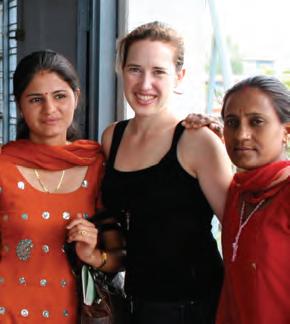

16 the expanding role of veterinarians
22 grassroots efforts make significant impact
29 elevating our animals departments
3 dean’s message
12 nbc case study
14 case study updates
18 campaign update
21 donor profile
22 tribute donors
31 obituaries
32 faculty & staff news
33 research briefs
34 alumni profile
35 vmas
36 class notes
about the cover:
The 2010 World Vet and Student Inspiration Award winners, from top left, clockwise, are Brittany Gross, V’13, Dr. Mo Salman, professor at Colorado State University, and Nikkita Patel, V’11. For the full story on these remarkable individuals who were honored this fall, see page 4.
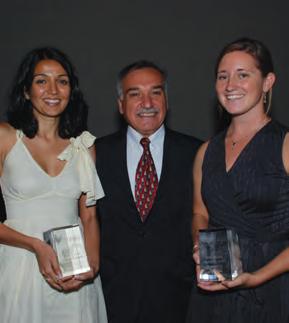
It’s the first rainy weekend in months and Penn Vet classes are in full swing after a long, hot summer. With autumn comes a change in seasons I love, with temperate conditions and a crispness in the air. But in addition to a welcome change from the sweltering summer, recent events and happenings at Penn Vet have brought us to a more hopeful, felicitous, optimistic place.
Simply put, it’s a new day at Penn Vet. I can tell because the most common greeting people gave me at alumni receptions and chance meetings throughout the summer was that they hear that we’ve “turned the corner.”
They are, of course, talking about the difficult – but wise and effective – downsizing we had to implement over the last 18 months or so, as well as the news that Pennsylvania’s appropriation and budget process has been stabilized for the 2011 Fiscal Year. While we must keep a wary eye on the state’s political and economic fortunes, we are striving mightily to take this opportunity to move forward with our clinical services, our educational mission and our stunningly successful research.
You will see evidence of this forward momentum throughout this issue of Bellwether. Over the last several months we have collected much good news to share (including a brand new Class of 2014 which totals 125 students with an average incoming GPA of 3.6) and have laid out some of the highlights within these pages. Our cover story is one such piece of good news.
For the third consecutive year, we have honored three remarkable individuals with the most prestigious awards in veterinary medicine, the World Leadership in Animal Health Award and Student Inspiration Awards. In addition to our coverage on page 4, JAVMA broke the story with an exclusive article on Dr. Mo Salman, this year’s World Vet Award winner, and included information on our Penn Vet Student Inspiration Award winners Brittany Gross and Nikkita Patel. The awards, which are graciously coordinated by former Dean Alan Kelly, are supported by a generous gift from the Vernon and Shirley Hill Family Foundation. (Nominations for the 2011 World Vet and Student Inspiration Awards are now open and guidelines can be found on our website, www.vet.upenn.edu.)
Also in this issue, I note with pride that Penn Vet is continuing to revolutionize veterinary medicine
with innovative programs to broaden the public perception of our profession. On page 16 in “The Expanding Role of Veterinarians,” we examine this revolution – which positions our students and graduates as authorities in developing ways to improve food animal production. We have noticed a shift in what students are looking for in a veterinary degree and are thrilled that they are eager to do good nationally and internationally by helping to feed the world and eliminate hunger.
In order to pursue such interests, students are actively seeking out travel opportunities to learn, teach and serve in areas such as Costa Rica, Thailand, Botswana and China. The opportunity for these international programs has never been greater, and, combined with students’ eagerness to help end malnutrition in developing countries, the curriculum of what is taught in the classroom has been expanded to meet those needs.
Our long-standing focus on animal welfare is also highlighted in this issue of Bellwether. On page 29, we examine how advances in this arena continue to shape public thinking and take a look at the trend of anthropomorphism. How have “pet owners” become “pet parents?” And how have areas like research, shelter design, food options and behavior modification training for our companion pets been influenced by this shift in thinking?
Of course all of this good news – recognizing student and professional leaders, shaping the future of the profession and pace-setting patterns of thinking – would be impossible without our friends and supporters.
We have included a Campaign Update on page 18 of this issue where you’ll see that with just two years remaining in our Making History: The Campaign for Penn Vet, we have already met more than 75 percent of our goal. The completion of the $125 million will enable us to continue our leadership in veterinary medicine by building state-of-the-art facilities for optimal patient care and teaching that will continue to attract the finest researchers, clinicians, staff and — most importantly — students.
Together, we can provide opportunities to students who will revolutionize the field, advance translational research and offer the ultimate in care to our patients. I hope you’ll continue to support Penn Vet’s legacy of leadership. It is an exciting new era, indeed.
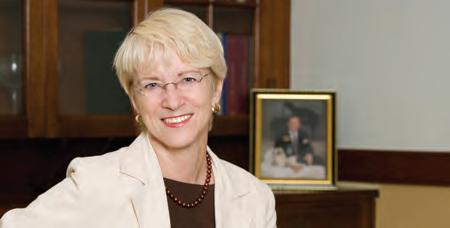
On Tuesday, September 28, 2010, Penn Vet celebrated its third annual World Leadership in Animal Health and Student Inspiration Award winners at the Annenberg Center for Performing Arts on Penn’s campus.
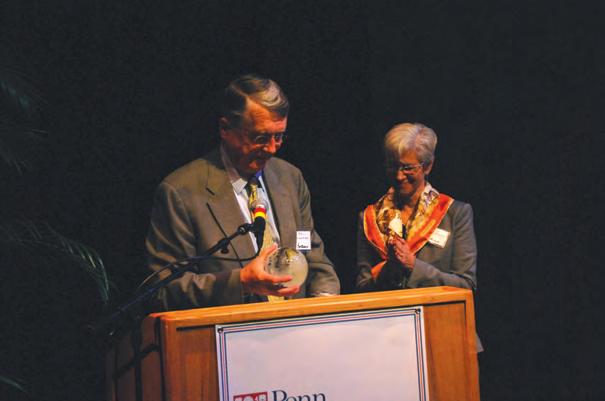
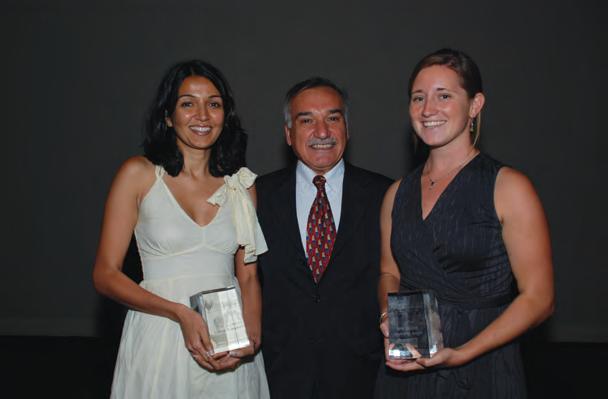
This year’s World Vet honoree was Dr. Mo Salman, a professor at Colorado State University. Student Inspiration honorees were Ms. Brittany Gross, a second-year Penn Vet student, and Ms. Nikkita Patel, a fourth-year Penn Vet student who is enrolled in the school’s VMD/PhD program. Each received a $100,000 unrestricted grant to use toward realizing their veterinary missions and proposed projects.
In addition, Alan M. Kelly, The Gilbert S. Kahn Dean Emeritus, University of Pennsylvania School of Veterinary Medicine, was honored with a surprise World Leadership in Animal Health Lifetime Achievement Award for his unyielding support and ongoing passion for the field of veterinary medicine.
“These awards are among the most prestigious and coveted in the world of veterinary medicine,” said Joan C. Hendricks, V’70, The Gilbert S. Kahn Dean of Veterinary Medicine. “I am always humbled and impressed by the innovative researchers, thinkers and student and professional leaders in the field that are named recipients. Dr. Salman, Nikkita and Brittany are no exception and I congratulate each of them for this distinct honor.”
The World Vet awards program was established with a major gift from the Vernon and Shirley Hill Foundation.
Penn Vet student proposals for the 2011 Student Inspiration Awards as well as nominations for the 2011 wor ld Vet Award are now being accepted. For more information to apply or to nominate a practicing veterinarian for his/her contributions to the profession, visit www.vet.upenn.edu
2010 world vet award committee
• Dr. John Albers, Executive Director Retd., American Animal Hospital Association
• Dr. Leland Carmichael, John Olin Professor of Virology (Ret.), Baker Institute, Cornell University
• Dr. Ron deHaven, Executive Vice President, AVMA
• Dr. George Gunn, BVSc, MRCVS, PhD, CEO, Novartis Animal Health
• Dr. Simon Harrus, DVM, PhD, Dipl. ECVCP, Director, Koret School of Veterinary Medicine, The Hebrew University of Jerusalem
• Dr. Leo Jeffcott, Dean Emeritus, Faculty of Veterinary Science, The University of Sydney
• Dr. Alan M. Kelly, Chair
• Dr. Joseph Kornegay, Director, National Center for Canine Models of Duchenne Muscular Dystrophy, University of North Carolina
• Dr. Fred Murphy, James W. McLaughlin Professor in Residence, University of Texas Medical Branch
• Dr. Soledad Macarena Vidal Ogueta, Directora Escuela Medicina Veterinaria, Universidad Mayor
• Dr. Bernard Vallat, Director General, OIE, World Organisation for Animal Health
2010 student inspiration awards committee
• Dr. Carla Chieffo, President, Veterinary Medical Alumni Society
• Dr. Peter Dodson, Professor of Anatomy, Labs of Anatomy, Department of Animal Biology
• Dr. David Galligan, Director of VMD/MBA Training Program
• Dr. Mark Haskins, Department of Pathobiology
• Dr. James Lok, Professor of Parasitology
• Dr. Rich Miselis, Head, Laboratories of Anatomy Professor of Animal Biology
• Dr. James Serpell, Director, Center for the Interaction of Animals and Society.
• Dr. Gary Smith, Chief, Section of Epidemiology and Public Health, Department of Clinical Studies
– New Bolton Center
• Dr. Sheldon Steinberg, Professor Emeritus of Neurology
Dr. Mo Salman, professor at Colorado State University, has been named the winner of the 2010 Penn Vet Word Leadership in Animal Health Award.
During his 37-year career in veterinary medicine, Dr. Salman has worked internationally in several capacities. His experience includes managing more than 160 scientific projects as principal investigator; serving as a member of the committee for Sustainable Global capacity for surveillance and response to emerging diseases of zoonotic origin within the Institute of Medicine, National Academy of Science; serving as chairperson of the examination committee and continuing organization committee of the ACVPM. In addition, he has held ranking positions in the USAHA and has been serving on the Animal Health and Animal Welfare Panel of European Food Safety Authority as well as on numerous committees and is affiliated with several professional associations.
In addition to his personal accomplishments in his veterinary career, Dr. Salman spent 31 years in an academic setting, teaching the next generations of veterinarians. He is also a well-published author with his work printed in the American Journal of Veterinary Research, Journal of Dairy Science, Journal of Food Protection and Journal of Wildlife Diseases among others.
Currently, Dr. Salman is a professor of epidemiology at the Animal Population Health Institute at Colorado State University. In 2009, he was named the recipient of the Alumni Achievement Award from UC-Davis, from which he earned his MPVM degree in 1980 and his PhD in 1983.
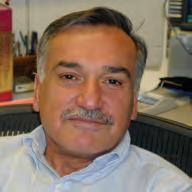
Brittany Gross, V’13, a native of South Sterling, Pennsylvania, is a secondyear Penn Vet student who earned an undergraduate degree from University of Vermont in biology.
“I’m different than a lot of vet students,” she said, “in that I haven’t always wanted to be a veterinarian. After graduating, I took time to explore my options. The global community has always fascinated me and so I figured traveling was a good place to start.”
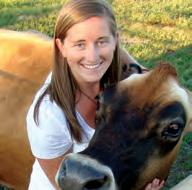
After college, Brittany spent a year teaching English in Thailand. And it’s in Thailand where she realized the valuable symbiotic relationship between people and animals.
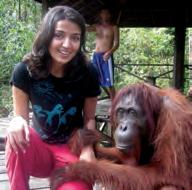
“Because I was starting everything new in Thailand, I was able to clearly recognize my curiosities as interests I never took the time to pursue,” she said. “I was naturally really drawn to the livestock industry in Thailand. People live so close to their food source and are in tune with their animals; their yard is their pasture. That’s when I gained a greater appreciation for the farm I grew up on back home and realized just how valuable animals are to us.”
It was from that one year that another light-bulb went off for Brittany and she decided to pursue a career in veterinary medicine – as well as a project she sent a proposal in for consideration for the Student Inspiration Award.
“I want to do what I can to preserve this small-scale style of farming in Thailand, which I believe will provide for food sustainability and food security for the future. In addition, my ideas involve simultaneously empowering and educating women,” she said.
According to Brittany, during her time in Thailand, she noticed that the sex industry is a problem.
“It’s very prevalent,” she said, “and it’s very unsettling. Low income and lack of education are factors that are known to support this industry. I don’t believe the sex industry is a product of inequality; women are valued members of society. The sex industry is tough to compete with – it allows for a lot of money to be made very quickly. However, the risks are high and I believe this option is ultimately the last resort for many women. There needs to be educational opportunities for women to stay in school and become excited for healthy career options.”
And so, Brittany’s idea for a Dairy Learning Center began to take shape.
Brittany’s Student Inspiration Award-winning proposal involves constructing an educationally focused dairy farm in the rural northeast region of Thailand. The dairy would be the site of afterschool programs that provide handson involvement and instruction in herd care, raw milk handling and dairy product processing. The involved students would learn valuable skills in a facility that models methods and technologies that are known to optimize milk production and that are feasibly implementable by the farmers in the region.
Female students will be elected into leadership positions, the implications of their meaningful involvement, Brittany states, are to provide empowerment and education to
a demographic that is pivotal in increasing literacy and graduation rates of an entire population. Brittany outlines that the long-term goal for the country’s dairy industry is less imported dairy products and increased domestic production as to ensure food security.
“Dairy farming is relatively new to Thailand, that is why education is so critical at this time,” she said. “Rice farmers are turning to dairy as a more profitable practice and the Thai government is supporting new dairy farmers with start-up loans to encourage this transition. The issue is that the dairy industry in Thailand is largely composed of first-generation dairy farmers. Educational programs could prove to be very valuable to dairy farmers, as changes made may directly translate to increased profit margins. Areas that are important for instructional programs include animal husbandry, animal welfare and most importantly, feed nutrition.”
Her plan, for the next three years, is to set the stage for success. Brittany has begun working with a vet school in Thailand to set the groundwork and relationship-building between the United States, Penn Vet and Thailand.
“After graduation, I plan to go to Thailand to arrange construction of the facility and begin the educational programs for nearby middle and high school students,” she said. “I knew that I would return to Thailand sometime in my veterinary career; I am drawn to the culture and the country’s dairy industry fascinates me.”
And she is thankful for the opportunity to pursue her dream.
“I am deeply honored and incredibly excited to have been granted the means to initiate the project I have outlined a decade sooner than would have been realistically possible,” she said. “This award is truly life-changing.”
Nikkita Patel, V’11, a native of Knoxville, Tennessee, is a fourth-year Penn Vet student who earned an undergraduate degree from University of Tennessee and a master’s degree in public health from Yale University.
“At Yale, I studied how diseases emerge and jump from humans to animals. I worked on this from the human angle, but I wanted to be more involved with the animal
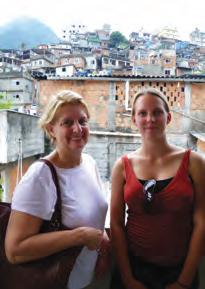
2009 Student Inspiration Award winner Katie Brinkley shares the progress she’s made one year after being honored
By Katie Brinkley, V’11, 2009 Student Inspiration Award WinnerFor the past year, I have been enrolled as a PhD student at the University of Pennsylvania’s School of Design. The Student Inspiration Award made this degree possible, allowing me to bridge the unique disciplines of urban planning and veterinary health.
Peri-urban animal agriculture is a growing sector that has unique possibilities to augment local food security. Yet, there may be limits to sector growth, acceptable types of animal agriculture and beneficial contributions to local food security. Understanding of both animal and human health, along with planning for growth and development of cities, is paramount as more than half of the world’s population lives in cities.
Before my PhD coursework began, I participated in the 2009 China Dairy program run by Drs. Dou, Galligan and Ferguson (see Spring 2010 Bellwether). The group was part of a consulting effort to examine planning, design and management for the burgeoning Chinese dairy system and provided an opportunity to learn about the rural farming systems that have sustained China for centuries and the modern, intensive urban farming systems that are being developed.
Similar urban planning tools exist in the United States (widely studied by my PhD adviser, Dr. Tom Daniels) and have greatly aided in farmland preservation. when I returned to campus to start PhD courses, I expanded on this firsthand knowledge with courses in food systems, sustainability policy, geographical information systems, and farmland preservation.
In addition to course work, this summer I was a research assistant for a United Nations project under the guidance of Dr. Eugenie Birch of the Department of Urban Planning. This work took me to Nairobi, Kenya to work with UN Habitat on a new case study development application that allows rapid transfer of data and ideas. The work culminated with the wor ld Urban Forum in Rio de Janeiro, Brazil where I presented the research team’s findings and attended many valuable meetings concerning food security and planning.
I am thrilled to have such an educational opportunity and I am grateful for the Student Inspiration Award, which has allowed me to combine the policy and planning aspects of food networks with veterinary medicine’s expertise in animal health and management.
For an update on the other 2009 Student Inspiration Winners’ project and their work with Heifer International, see page 10.
side,” said Nikkita, whose maternal grandfather ran a gaushala (cow sanctuary) in India.
Nikkita decided to pursue the VMD/PhD program at University of Pennsylvania where she will have the opportunity to continue to work with animals and with people and explore her interests of how human lives intersect with and impact animal lives and vice-versa.
“The Student Inspiration Award was so innovative and it spoke to exactly what I want to do, and, honestly, it was one of the big reasons I was drawn to Penn Vet,” said Nikkita. “I have so many interests. I want to illustrate to people the ripple effects their actions and inactions can cause. Conservation is a passion of mine and I want to showcase wildlife and the consequences our actions have on them and us.”
The tool Nikkita plans to use to educate people on their actions and lifestyles is the Internet – specifically Google Earth.
In her award-winning proposal, titled “Veterinary Public Health 2.0,” Nikkita writes, “Veterinarians are evolving to have the responsibility of stewards of the planet. Within this role, it is our duty to educate the public on the depth and breadth of current problems that we are working to help solve, encompassing public health, conservation and environmental health. Web 2.0 will be used within this context to 1) re-empower the individual and 2) provide a powerful resource for policy makers.”
Her planned starting point will be the collection of data to plot onto Google Earth maps, focusing in on Asia.
“Asia has a lot of threats, but not as much attention,” she said. “Plus, culturally, I can understand the various viewpoints better, too.”
The funds of the Student Inspiration Award will help Nikkita get started as will the experience she garnered during a summer spent at Google.
“Education of the public is something veterinary professionals are not very active in, yet is so important,” she said. “I plan to visualize the problems of wildlife trade using Google Earth and show how devastating it is for wildlife, humans and ecosystems. Through the generosity of Mr. and Mrs. Hill, I hope to harvest the power of the web to spawn a global movement for the wildlife trade and other veterinary issues. It is such a great honor to receive this award, which will allow me to pursue a project that represents a confluence of my dreams, personally and professionally,” said Nikkita.
Over the past several months, Penn Vet has had much to celebrate including Alumni Weekend; the grand opening of the state-of-the-art James M. Moran, Jr. Critical Care Center at New Bolton Center; the Student Inspiration and World Vet Awards; the incoming Class of 2014; the annual Rush Shippen Huidekoper Dinner, which this year featured Dr. Jeffrey Runge as keynote speaker and where students honored Dr. Rose NolenWaltson; Commencement for the Class of 2010 with special speaker Dr. James A. Wight, son of beloved author James Herriot; and a Survivors’ Party, hosted by Ryan-VHUP’s Intensive Care Unit.

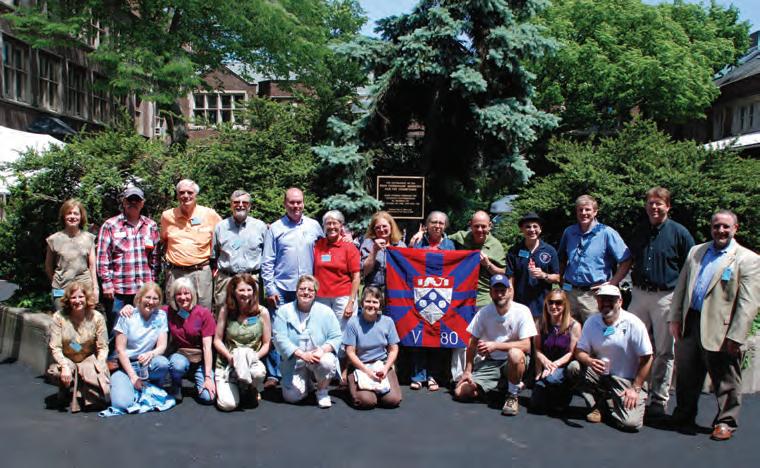
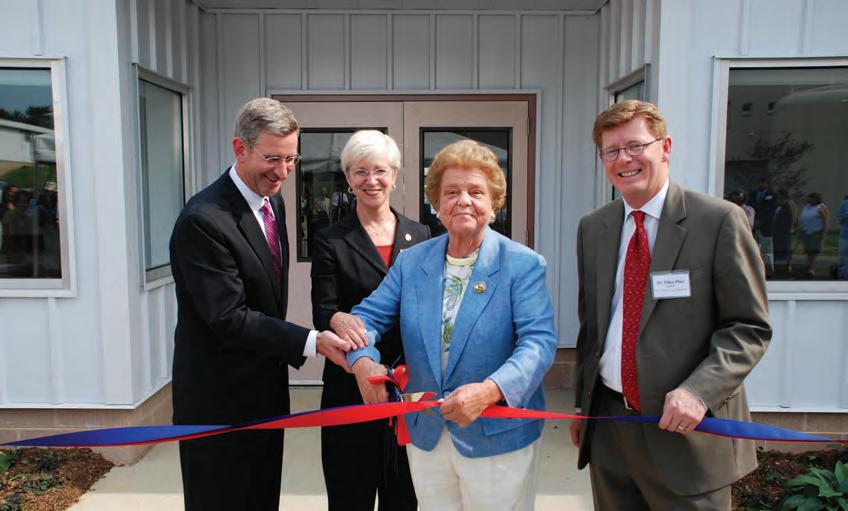
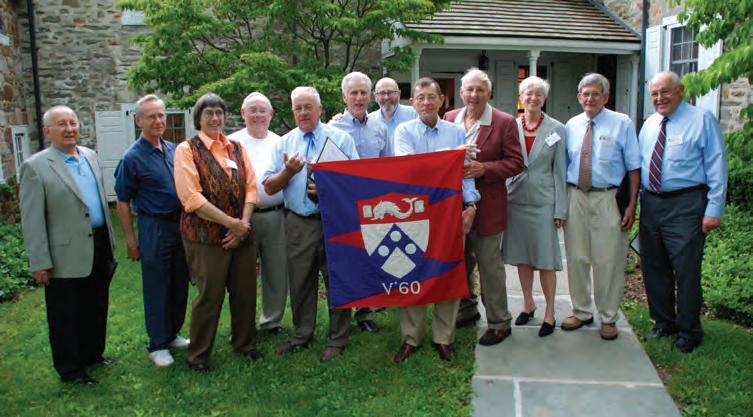
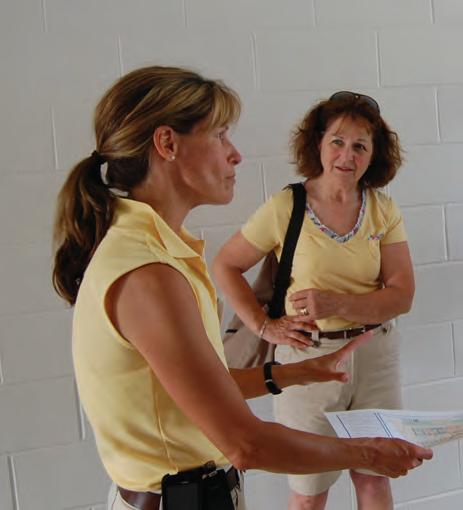

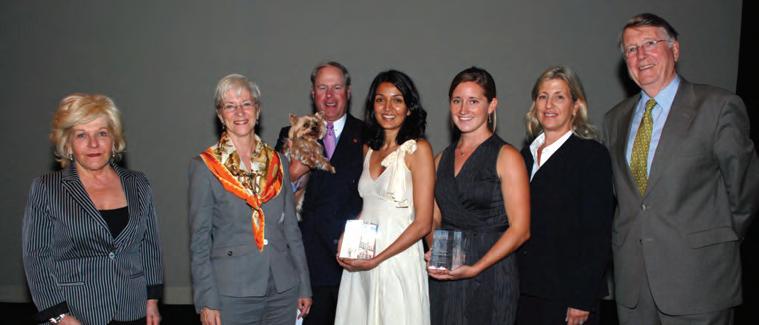
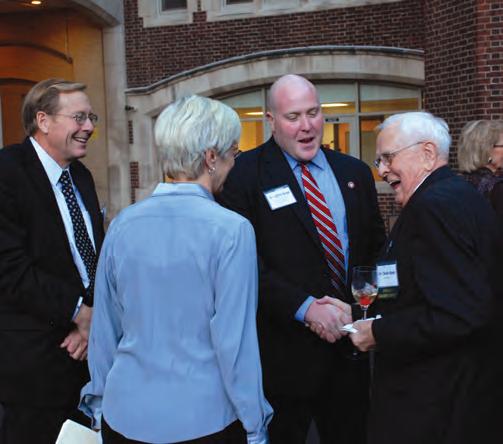


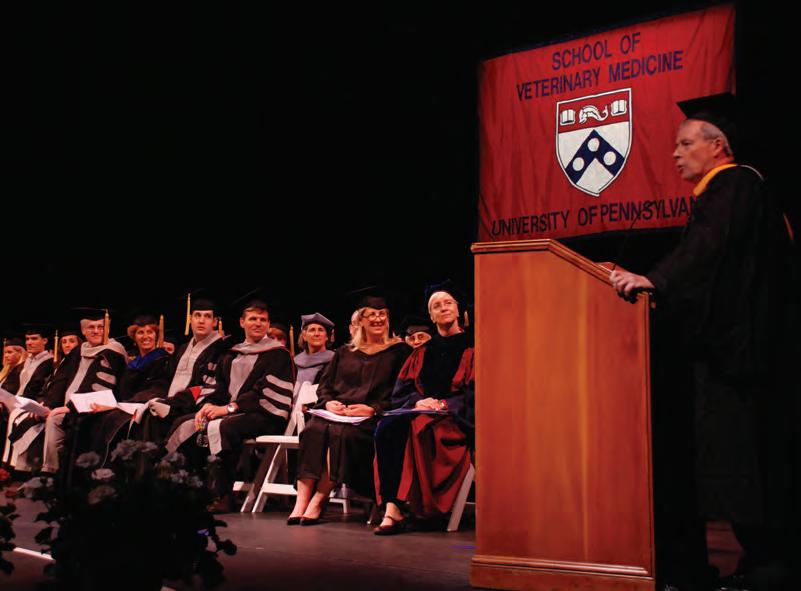
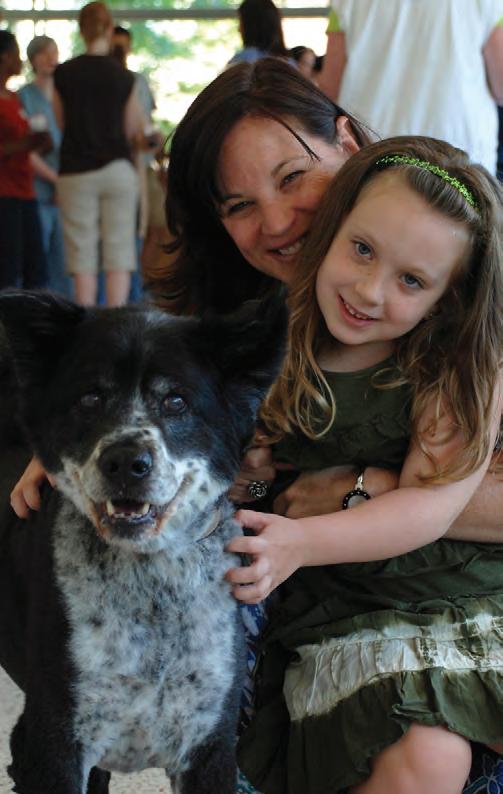

g g g g g g g g g g g g g g g g g g g g g g g
On Heifer’s suggestion, we begin our work in Nepal – a small country sandwiched between India and China. Heifer has been extremely successful in working with Nepalese communities, yet there is still a great deal of poverty and need across the country. Two vet students were chosen to accompany me to Nepal for four weeks this summer.
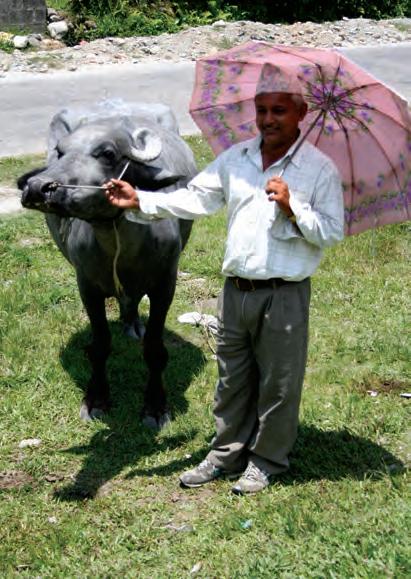
There are many ways veterinarians (and vet students) can contribute to improving health and productivity of livestock on small farms. In addition to traditional methods (vaccinating, de-worming, basic physical exams), vets can act in an advisory capacity to farmers in matters of animal husbandry, nutrition, welfare and productivity.
By working with Nepali veterinarians, we are working to offer animal nutritional counseling to farmers and community leaders; as such, our trip this summer consisted, in part, of a scouting-out of the farming and livestock practices of Nepal. We visited and surveyed a total of 85 farms in rural villages of Nepal’s Kaski district, obtaining information on animal health, nutrition, husbandry and reproduction, as well as an assessment of some of the basic forages and concentrates available for Nepalese livestock. The goal is to use this information to help farmers develop optimal nutrition and husbandry plans for their animals using locally available resources.
Along with research and medicine, veterinarians can provide the asset of education through the training of local paraprofessionals. These paraprofessionals (“paravets”) can provide very basic animal health care to village livestock.
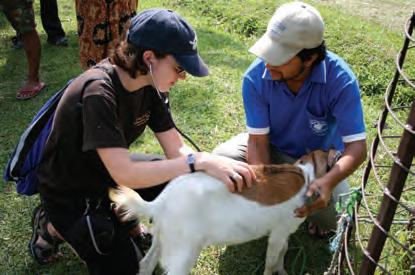
Like most other countries, Nepal is facing a serious shortage of large animal veterinarians, especially in some of the more remote parts of the country. Nepal has two agricultural schools that graduate 60 vets per year. However, around 40 percent of those graduating vets leave Nepal to work or study abroad and a large percentage of those that stay in Nepal take government jobs; very few Nepali vets work in rural areas.
To address this dearth of veterinarians, paraprofessionals are being trained in basic animal health. Not only does this solution address the lack of animal health resources, it also provides tangible benefits to the community. Training of paravets (or Village Animal Health Workers (VAHWs)) results in community leaders who are familiar with and invested in their communities. These VAHWs not only improve the health of village animals, but they pass on their knowledge to teach farmers about improved animal care. VAHWs become respected sources of knowledge and leadership within a village with access to networks of government and health professionals. Indeed, Heifer’s work of community-building relies on the presence of such community leaders.
While in Nepal, we collaborated with the Animal Health Training and Consultancy Services (AHTCS), a partner organization to Heifer that trains VAHWs. AHTCS organizes five-week-long training sessions for villagers who want to learn about basic animal health care.
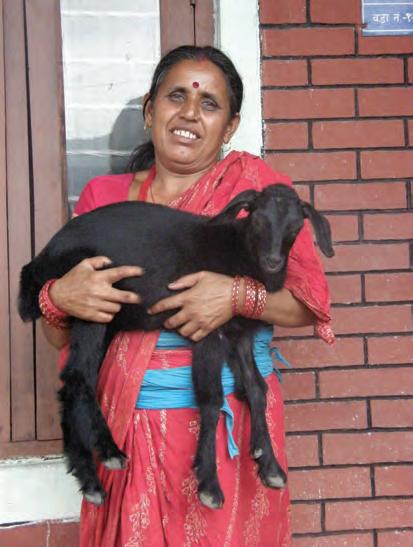
Veterinarians have the unique ability to fight world hunger by promoting the health and productivity of small farms. By creating an alliance between Penn Veterinary students and the non-profit organization Heifer International (www.heifer.org), two Penn Vet students set up a project that aims to inspire the veterinary profession into becoming the bridge between human health and prosperity and animal medicine. The effort was the award-winning proposal of Laurel Redding and Alison Barnstable, both V’11, who received one of the 2009 Student Inspiration Awards for their project.
Laurel and Alison’s project proposed a team effort with Heifer International, an organization that helps empower families and villages through community development and the gift of animals. Through the partnership, Laurel and Alison would enable other veterinary students to learn about the issues of the developing world and teach them how they can have a significant impact on animal health in developing communities where people depend on animals for their livelihood.
This summer, Laurel traveled with two Penn Vet classmates, Yoon Chay and Lauren Aldinger, both V’12, to Nepal to begin realizing the proposal she and Alison had begun. Here’s her update from the field.
Part of our Student Inspiration Award funds went towards the training of 12 VAHWs from different parts of Nepal. We were also able to attend and participate in the training sessions that included a series of lectures taught by veterinarians and veterinary technicians. Subjects of the sessions ranged from anatomy to animal restraint, from drug administration to diagnosis of infectious diseases, from basic surgical techniques to design of animal housing. Participants also gained first-hand experience by seeing cases from neighboring villages that use mostly water buffalo, cattle and goats, which are the primary livestock found in Nepal.
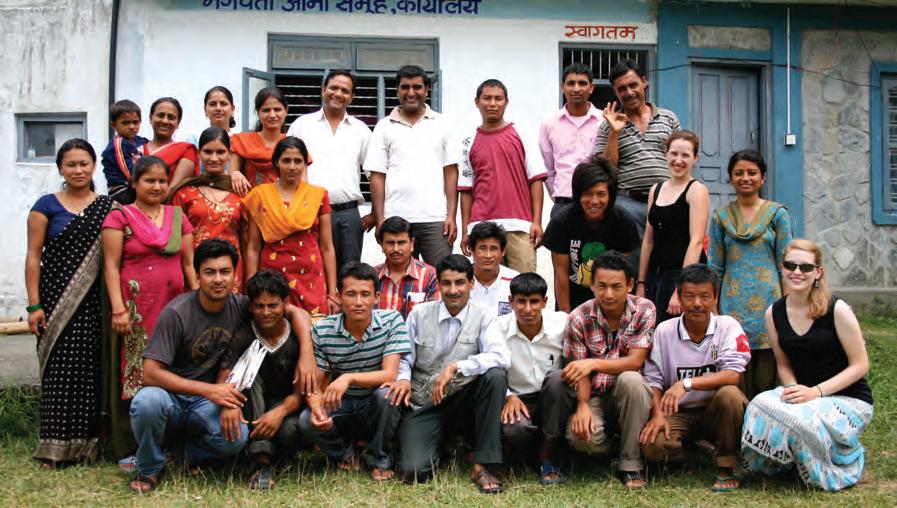
Training of paraprofessionals is an important way for veterinarians to reach as many households and animals as possible. Just as one community started by Heifer can expand into many communities, training one VAHW can have a positive impact on a large number of animals and families in one village. The VAHWs have the potential to be a source of inspiration, motivating other villagers to learn new skills and to share those skills.
Our project involves supporting animal health training programs and contributing to it with both our knowledge of advanced veterinary medicine and understanding of the local conditions and resources of a developing country. By continuing our work with AHTCS and Heifer in Nepal, we plan to work with Nepali veterinarians and farmers on implementing solutions for improved animal productivity.
Nepal faces food shortages and currently imports a large percentage of its food, even though it is a nation where 66 percent of the population is involved in agriculture. The animals we surveyed on Nepali farms were, for the most part, very low producers. Cows produced an average of 1-2L of milk a day. (Holsteins in the US produce on average 50L of milk a day.) Water buffaloes produced an average of 3L. Goats, which are sold for meat, need increased body condition scores and larger numbers of offspring. These improvements can be reached by improved nutrition and reproduction.
As our world grows more and more interconnected, the role of veterinarians will become more globally focused. We hope that our project will be a successful model that can be used in other parts of the world. Short-term clinics and spay/neuter programs in developing countries are certainly one way that veterinarians can contribute to animal health care, but the effects may be short-lived. We hope that working with farmers to improve productivity and that training local townspeople in basic animal health will have more permanent effects.
We also expect that vet students who participate in the program will become more globally aware and acquire skills and knowledge that they can apply later on in their career.
However, we cannot do this task alone – it is only with collaborators like Heifer International and AHTCS who know the communities and country intimately, that we can have a passing chance at being successful.
To learn more about Laurel’s, Yoon’s, Lauren’s and Alison’s work in Nepal, check out the blog that the three who traveled this summer kept: http://nourishnepal.wordpress.com. To become involved with the project, you can contact Laurel or Alison via email at lredding@vet.upenn.edu or abarnsta@vet.upenn.edu, respectively.

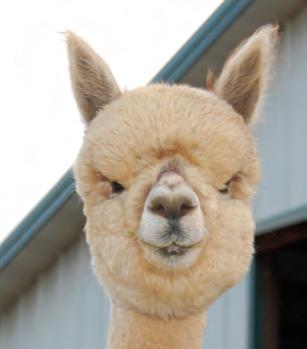 B Y S A LLY S I LVERMAN
B Y S A LLY S I LVERMAN
Dr. Mary Utter was charmed the moment she saw her patient in late January, 2010. Star Dancer was a three-monthold cria (baby alpaca) with big beautiful eyes — but it was those eyes that caused the concern. They weren’t dark and glossy the way the eyes of a cria should be. Star Dancer’s eyes were cloudy at the center. This baby was born with cataracts.
Cataracts are familiar to most of us. According to the World Health Organization, cataracts are the leading cause of serious vision impairment in humans around the world, causing, in 2002, an estimated 47.9 percent of all blindness. Although commonly believed to be a function of age, a cataract technically is any opacity of the lens in the eye and can occur at birth or develop with age for a number of reasons. The problem has been reported to occur in many species and the degree to which they impair vision is quite varied from insignificantly to completely.
In Star Dancer’s case, she appeared to be almost totally blind from birth. At home she clung close to her mother and was disinterested in interacting with the other crias in the herd. Though they reported that she could get around “well enough” and her vision wouldn’t impact her function as a producer of fine fibers, owners Jim Bajzath, Bonnie Belfiore and Doug Kittrell felt that Star Dancer’s quality of life was compromised. And so, they came to New Bolton Center to investigate the possibility of cataract surgery.
People often have cataracts removed and artificial intraocular lenses inserted during the same surgery because restoring perfect visual acuity is important in people. We need sharp vision to do everyday things like read and drive.
In veterinary medicine, however, “the significance of visual acuity is dependent on the needs of the animal,” said Dr. Utter. At New Bolton Center, horses undergo cataract surgery because sight is such a crucial part of so many of their activities. (Imagine jumping a five-foot
ditch with compromised depth perception, or negotiating a racetrack at 45 miles an hour with fuzzy vision.)
But there is another reason that leads people to pursue cataract surgery for their animals: quality of life. The same individuals who have their cataracts removed and corrective lenses implanted are frequently electing to have the same surgery performed on their dogs. And, reports Dr. Utter, a large portion of her equine patients are those horses that would no longer be considered performance animals but are beloved pets when receiving the benefits of cataract surgery, simply because their owners believe it would enhance their quality of life.
In camelids, the family of animals that includes camels, llamas and alpacas, the surgery is not commonly elected because these animals are not as often considered as pets. In Star Dancer’s case, however, her owners believed that the ability to see, even if imperfectly, would greatly enhance her quality of life. Artificial lenses are commercially available for dogs, cats and horses but they aren’t available for camelids; without an artificial lens, the patient would be quite far-sighted postoperatively.
Since she began practicing, Dr. Utter, a board-certified veterinary ophthalmologist, has performed eye exams or surgery on a pit viper, crocodile, Siberian tiger, hyacinth macaw, kangaroo, zebra, chinchilla, as well as domestic pets and farm stock. Her practice has been limited to New Bolton Center since 2006, and here she has operated almost exclusively on equines, bovines and, yes, camelids.
When Star Dancer arrived at New Bolton Center, at only three months old, she presented in general good health. An ophthalmic examination revealed an absence of a menace response, where the hand is rapidly pushed towards the eye without making contact; a normal response would be to blink or pull back at such a threat. Dazzle and pupillary light reflexes in both eyes, however, were positive, suggesting that the retina was functioning
properly. The eyes appeared to have no abnormalities other than the cataracts, and the likelihood that the cria’s vision would be corrected with surgery was good. In her stall, Star Dancer walked in circles, her head tilted upward. Routine phacoemulsification, the process by which cataracts are broken into microscopic pieces and removed from the eye, was recommended.
The surgery, even though it is a common procedure, is technically challenging, demanding extreme precision. The patient is placed under general anesthesia and a neuromuscular block is used; the globe needs to be positioned in a precise way; any movement could compromise the quality of the surgery. Performed under a surgical microscope, a small incision, about the diameter of a pencil eraser, is made in the cornea, described by Dr. Utter as “the windshield of the eye.” The cloudy portion of the lens is broken down through phacoemulsification, using high-speed ultrasound, and then aspirated from the eye. The opening is closed with an absorbable synthetic suture material about the diameter of a human hair.
The positive response to the cria’s surgery was thrilling for Dr. Utter and the rest of the surgical team.
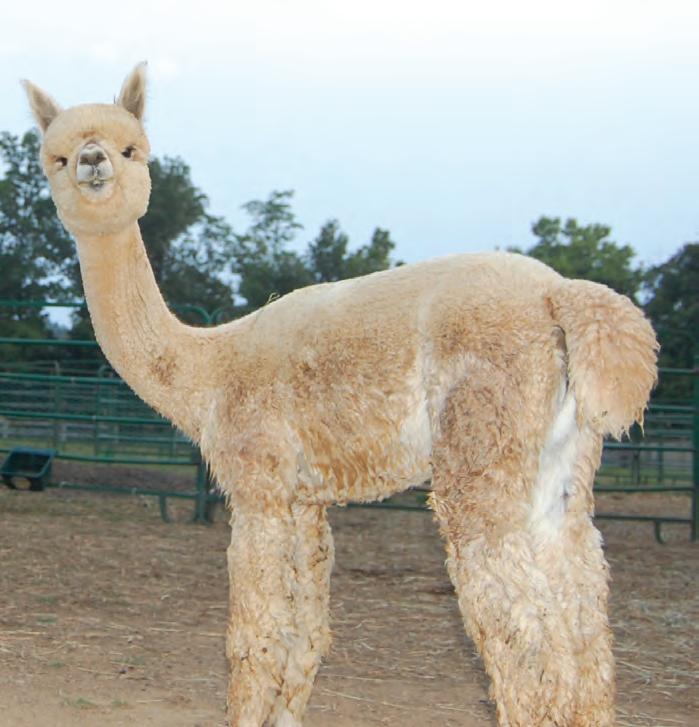
“As soon as Star recovered from general anesthesia, we could see a difference,” said Dr. Utter. “She was responsive to a menace test, interested in her environment and began investigating her surroundings almost immediately.”
The cria, however, was still in a delicate position. She received systemic and topical antibiotics and antiinflammatories before and after surgery and throughout her two-day hospitalization. Medication was given intravenously to protect against gastric ulceration that could result from both the stress of hospitalization and the systemic medications. She was sent home with topical antibiotics, steroidal drops and atropine. While her prognosis for continued good vision, though far-sighted because no artificial lens was inserted, was excellent, it was emphasized to the owners that post-operative complications, including uveitis, glaucoma and corneal edema, were still possible and could be both painful and result in blindness. Star Dancer’s at-home care and daily monitoring were of utmost importance.
When Star Dancer returned to New Bolton Center one week following surgery, Dr. Utter found that she was bright and seemed to be seeing well. A mild amount of corneal clouding and low intraocular pressure were observed; these were deemed appropriate following cataract surgery. Another recheck two weeks later showed continued improvement.
Star Dancer’s owners reported that as soon as she returned home she began investigating her surroundings for the first time with her eyes instead of her nose, mouth and ears.
In a recent update, six months after surgery, Doug said, “Star can see, but her peripheral vision is not as good. She gets lost once in a while if the herd heads to the barn and she doesn’t notice because she has her head down grazing. When she picks her head up and looks around, she gets a bit nervous. The key, though, is that she looks around.”
Her sight appears to be best when focused on something that’s moving. “When she is playing with the spring crias, she runs right with them and tracks them fine,” said Doug. “It was worth it to have the surgery. It makes her quality of life better and makes managing her much easier. One of the reasons we had the surgery performed was we were in the process of moving and knew that a complete change of environment for a blind alpaca would require a lot of extra management and monitoring. Star Dancer adapted to her new surroundings as quickly as any of the other alpacas in the herd. It warms our hearts to see she no longer runs in tight little circles, but instead pronks in long leaps through the pasture with the other young alpacas.”
“This isn’t necessarily a story of an innovative or particularly uncommon surgery,” said Dr. Utter. “But it is a story that emphasizes so clearly the impact that we as veterinarians can have on the quality of an animal’s life. It has been so rewarding to get updates on how much we were able to make a difference for Star.”
Frances Wade-Whitaker spent the night of July 9 with her husband and a bottle of champagne. They were celebrating survival.
“I had some real anxiety coming up on the year anniversary,” said Fran. “But I feel emotionally better now. I made it through Suki’s first year and we celebrated how far she’s come.”
On that July date last summer, Fran’s horse Suki was caught in a barn fire. After treatment at New Bolton Center and several months at a layup facility, the horse was moved in May to a regular boarding facility.

While the burns the horse suffered have mostly healed, there is one section on her back that has been especially difficult.
“It’s finally starting to heal,” said Fran. “I clean it and exfoliate it constantly and it’s getting smaller and smaller.”
Fran also applies sunscreen to Suki’s sensitive face and back to protect the skin from sun damage. Being able to touch the horse’s face is another milestone met – for months after the barn fire, Suki wasn’t able to wear a halter and could be difficult when vets and techs would apply antibiotic ointment to her injuries.
Suki’s story in the spring issue of Bellwether struck a chord with many readers, but especially touched was Penn Vet alum Lori Ferdock.
“I wanted to let Fran know there was a burn community out there,” said Lori, whose 11-year-old son Vincent is a burn survivor. “I wanted to let her know that something good could come out of something so terrible and I asked if I could share Suki’s story at the Burn Center.”
Lori, a small animal veterinarian at a practice in Gilbertsville, is also a passionate volunteer at Lehigh Valley Hospital’s Burn Center. After her son’s accident four years ago and realizing
support for children burn survivors was lacking, Lori chose to devote much of her free time to working with survivors and getting them to open up and talk about their scars in a supportive environment.
Fran gladly agreed to meet Lori and granted permission to share Suki’s story with the survivors at the Center.
“Fran was very excited about the thought of me sharing Suki’s story and we decided to work on a children’s book about it,” said Lori. “My initial thought was to write the story specifically for burn centers, but I think it would be a good children’s book for a wider audience, as well.”
Lori’s son Vincent, or “Vinny” as his family calls him, was severely burned more than four years ago and has been undergoing various phases of treatment ever since. Lori knew that children and animals have a special connection and wanted to introduce Suki to her son.
“He was intimidated by her at first,” said Lori, “but after a little while they found a peace with each other.”
Ayear ago this month, a dog named Diablo was fighting for his life in the Intensive Care Unit at the Matthew J. Ryan Veterinary Hospital at the University of Pennsylvania (Ryan-VHUP). A member of the New Castle County Police K-9 unit in New Castle, Delaware, he’d been shot in his left hind leg and in his chest in the line of duty.
Dr. Elaine Holmes, now a third-year surgery resident at Ryan-VHUP, and Dr. Kimberly Agnello, assistant professor of surgery, performed a successful repair of Diablo’s shattered leg (his chest wound was a graze), but post-op, the dog’s status took a turn for the worst as he battled pneumonia in the Hospital’s ICU. Twenty-some days later, the dog had progressed enough to be released to the care of his handler, Corporal Chris Sarnecky.
After a few months of bed rest, Diablo was ready to start physical therapy.
“We tried to get him on a treadmill in the water, but he hated it,” said Corporal Sarnecky, “so we tried to get him in the pool without using the treadmill. He hated that, too, but one day he decided he liked it. So we’d go twice a week, I’d put his little vest on and throw the ball for him for 30 minutes at a time. It was amazing how fast he grew muscle in a couple of weeks.”
Diablo was getting stronger, but he wasn’t out of the woods.
“His plate has had an infection on it since they put it in,” said Corporal Sarnecky. “He was treated with antibiotics and that seemed to work, but the infection came back.”
The pesky infection just wouldn’t go away and so Dr. Holmes and Dr. Agnello decided they’d take a look at the plate and consider removing a couple of screws to abate the problem. After taking X-rays at Diablo’s early-September checkup, however, they opted to remove the entire plate.
“Everything went very well,” said Dr. Holmes. “He had developed a chronic draining wound over the distal aspect (bottom part) of his plate. We attempted to manage that conservatively with antibiotics while he continued to heal his bone and build up a strong diaphysis (middle part) where it was destroyed by the bullet. We took X-rays prior
to his explant that showed improved bone stock so we went forward and removed the plate and all of the screws. He was walking well on both legs when he left the hospital.”
In October, Diablo’s X-rays showed that new bone growth was evident at the screw-hole sites — a positive piece of news for Corporal Sarnecky — and Diablo.
During Diablo’s recovery, Corporal Sarnecky acquired a new dog with which he can train. Cooper, also a Belgian Malinois, is a lot like Diablo.
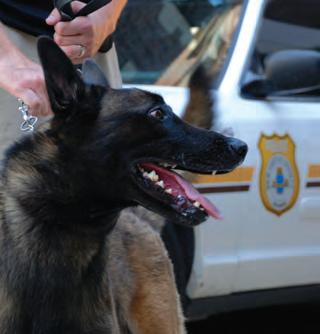
“I picked Cooper out myself and I knew what I was looking for — a high working drive and a dog that was social with people,” said Corporal Sarnecky. “When I first got Diablo he was so go-go-go and I thought, ‘This dog is crazy.’ But he wanted to go to work. When we hit the street, I loved it. Cooper has that same type of personality.”
While the two dogs have not yet been introduced for safety reasons, Diablo knows there’s another dog there, said Corporal Sarnecky. “He looks at me like, ‘What’s going on here?’”
Cooper and Corporal Sarnecky started training together in mid-September. And Diablo? He’s become an official member of the Sarnecky Family.
“He becomes the family dog,” said Corporal Sarnecky. “He’s good with my 2-1/2-year old and my 1-year old. When he comes flying at them full force, it can be a little much, but he’s still young, he’s got a lot of energy and he’s great with them.”
Overall, Diablo is a complete success story.
“When he’s walking, there’s a little hobble in his step,” said Corporal Sarnecky. “If you didn’t know something major had happened to him, you would never be able to tell what he went through.”
Dr. Agnello agrees.
“We’re all very excited to see him return to his unrestricted normal activity,” she said. “And hopefully his infection is cleared and he no longer limps or has any pain. He is a great dog with a lot of energy and we hope he can return doing all the things he loves!”
For a short video clip of Diablo during aqua-therapy, visit www.vet.upenn.edu.
Whilethe idyllic practice style of James Herriot may still fuel the passion of many veterinarians and vet students, the role of the profession is expanding.
Today, in addition to the traditional roles of protecting animal health, veterinarians are major players in food production practices and are influencing global food policy. This idea – that vets play a role in feeding the world safely –is fairly new.
But there are challenges with this new role, including a broad understanding of food production paradigms, water and arable land scarcity, global warming and political strife.
When large animal veterinary education began, explains Penn Vet’s Dr. James Ferguson, V’81, professor of clinical nutrition and chief, Animal Production Systems, the goal was to eradicate diseases to protect food supply. In the late 1800s, veterinarians served the health care needs of individual animals and of the herd, which remained the focus as recently as the 1980s.
However, as the agricultural landscape evolved, opportunities for veterinarians to play a more expansive role in food animal production increased.
“Agriculture in this country has changed dramatically,” said Dr. Alan Kelly, The Gilbert S. Kahn Dean Emeritus of the Vet School. “As the emphasis on cheap food has grown and the value of the individual animals has declined, farms have consolidated and their numbers decreased. With the pressure for cheaper food the paradigm shifts to the broader aspects of producing animals humanely, at the lowest possible cost and in the most environmentally sensitive way.”
To achieve these goals, veterinarians are an integral resource in designing models to help producers. With their training in comparative medicine, said Dr. Kelly, vets have a broad view of disease in humans, livestock, wildlife and the environment.
In 1986, Penn Vet opened its Center for Animal Health and Productivity, which focuses on the physical and economic health of the animal population and marries disciplines such as clinical nutrition, reproduction, health economics and computer science with conventional veterinary specialties.
One way the Center has had an impact is through an increased understanding of animal nutrition. Here, faculty members develop ration programs to promote economic and environmental efficiency. Because production of milk, for example, is directly related to the feed quality, an increase in efficiency can yield a need for fewer cows. Often, wealth is measured by the number of animals an individual owns; the mindset must be shifted to recognize wealth in terms of production capabilities, not numbers.
“Because animal production is very complicated and nuanced,” said Dr. Dave Galligan, V’81, director of the Center for Animal Health and Productivity and professor of Animal Health Economics, “part of our role in influencing global food production is to give the producers the tools to make the right decisions.”

According to the World Health Organization, starvation kills more people than HIV/AIDS, tuberculosis and malaria combined. In developing nations, those with rising incomes are looking toward animal proteins to increase the nutritional value of their diets. Complicating matters are endemic infectious diseases of livestock in many of these nations, which reduces animal health and production. These must be controlled before capital is invested in systems.
In addition, the Food and Agricultural Organization of the United Nations projects the need for a 70 percent increase in food production by 2050 in order to meet the demands for animal protein with little appreciable increase in arable land.
Today’s vets serve their traditional animal health duties and take on expanding global responsibilitiesB
Y S A LLY S I LVERMAN
“[A]mong veterinary students in the US there is a ground swell of interest in these dynamics founded in the knowledge that the profession can play an essential role in alleviating poverty and hunger, helping poor nations enter world markets and in bio-security for the United States,” said Dr. Kelly, who serves as chair of the National Academies of Science study on Workforce Needs in Veterinary Medicine.
“It is, in fact, the students who are pacing us,” said Dr. Ferguson. “They are taking on a broader vision of how they can play a role in solving the issue of hunger.”
And so it only makes sense that students’ education is expanded.
“They need to know nutrition and all parameters of health, as well as the business of the farm,” said Dr. Kelly.
The curriculum at Penn Vet has evolved and now offers courses on animal health economics, dairy production medicine and developing systemic approaches to herd health. A Veterinary Public Health Course, spearheaded by Dr. Kelly, has moved from a bacterial, biological emphasis to emphasize responsibility for production with minimal environmental impact.
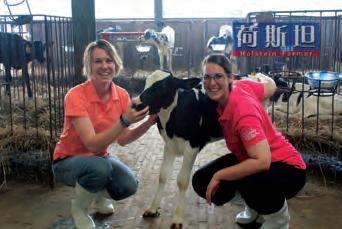
Combined degrees give students broader access to the tools vets need to shape global food policy. The VMD/MBA, for example, combines the role of veterinary practice economics as well as the economic impacts of veterinary medicine.
Comparison study is also featured. For the past two years, under the leadership of Dr. Zhengxia Dou, associate professor, Animal Production Systems, a group of students has traveled to China, visiting dairies and exchanging ideas. (See Spring 2010 Bellwether.)
Penn Vet has positioned itself at the forefront of this changing role and faculty, students and staff are focused on animal health as well as finding ways to increase animal production economically, safely and efficiently.
“Penn has always been unique in terms of looking at new dimensions of veterinary medicine in which to evolve,” said Dr. Galligan. “We were the first school to focus on animal health economics and the first school with a nutrition program focusing on animal production rather than disease. What makes us unique is our broad perspective of what the problems are.”
Dr. Ferguson envisions an educational program that is unique among veterinary schools, where 20 percent of graduates work in global food policy.
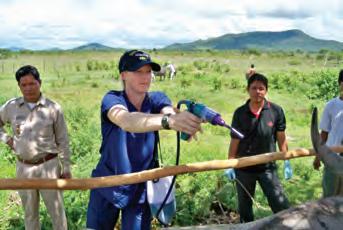
“We are early in this,” Dr. Ferguson said. “We might be unique in the concept of food production and its impact on human health and animal health and the impact on the environment.”
“Veterinary medicine keeps trying to push into public health and everybody is surprised all the time,” said Joan C. Hendricks, V’79, The Gilbert S. Kahn Dean of Veterinary Medicine. “But veterinary voices need to be heard in the public sector. We have a unique and broad education that is good for the world.”
This summer, Penn Vet students traveled to China with faculty and staff from the Center for Animal Health and Productivity to broaden their education. After time in China, several stayed abroad, expanding their understanding of agricultural practices in different cultures.
I worked with World Vets in Cambodia on board the USNS Mercy Hospital Ship. Under direction of US Army veterinarians, we provided humanitarian and civic assistance alongside medical, dental and engineering teams. Our primary focus was on public health, food safety and security and animal medicine.
The Pacific Partnership fosters cooperative relationships between national governments, international organizations, non-governmental organizations and partner militaries and began after the 2004 Asia tsunami. Since then, the partnership travels for four months each year visiting countries in Southeast Asia.
It was incredibly rewarding to be a part of an international team. The scope of impact was visible both at the leadership level and at the village level where water buffalo still predominantly worked in the fields. Our veterinary team focused on villages because animals are critical to their survival in terms of both for food and labor. The Cambodian veterinarians were receptive to teaching us about their practices and welcomed us to engage within their communities. I experienced an eyeopening aspect of veterinary medicine that will help shape my career.
When the two-week group trip ended we stayed in China, spending the remainder of our summer at Huaxia Dairy Farm, a large facility milking 3,000 cows with almost as many young heifers. While there, we focused on a different area of the production process each week, from mastitis to feed management to reproduction.
The challenges to efficient production were apparent. One example of the input we offered was on the health of dairy calves. We worked to improve colostrum management, helping farmers understand that healthy calves make healthy cows, and healthy cows produce more milk. We also helped Huaxia understand that quality feedstuffs were just as important as a well balanced ration formulation. We worked with dairy managers and growers to find a better harvesting plan that would not compromise nutrient value while increasing milk production and improving economic value of the feedstuffs.
This was a great opportunity culturally and to cement some of our knowledge of vet-related topics, dairy management and production. It was also a lesson in how agriculture is intertwined with culture, politics and people.
For more international summers experienced by Penn Vet students, visit www.vet.upenn.edu.
Campaigns are designed to help institutions take giant steps toward meeting their top priorities. Making History: The Campaign for Penn Vet was launched in 2006 and is helping to transform the School and offer unparalleled support to students and faculty, the best care possible for our patients and funding for our trend-setting translational research efforts.
To date, Penn Vet has raised $96 million of its $125 million goal; however, with just two years remaining, there are still important goals to reach. Here, we’ve highlighted some significant achievements as well as outlined our fundraising priorities that will have a tremendous impact on our three-fold mission of education, research and service.
Physical space and state-of-the-art technology is a vital priority of any research institution and Penn Vet is no different. Top-tier hospitals equipped with the latest in technology enable students to receive a first-class education, while also providing patient care that is unparalleled and new laboratories conducive for cutting-edge research.
Thanks to leadership support from Betty Moran and the Commonwealth of Pennsylvania, the James M. Moran, Jr. Critical Care Center at New Bolton Center was opened this past summer. The Center, which was originally conceived in 2006, provides state-of-the-art learning opportunities for students as well as top-tier care for equine clients.
The building is completely bio-secure and includes two separate wings: one for colic patients; the other for gastrointestinal clients, preventing direct interactions between patients. All stalls are completely self-contained with individual access from the outside. Each patient enters its stall by one door and exits the same way. Patients do not cross another’s path.
A particularly important feature is air pressurization of the central corridors relative to the stalls which ensures that all air transfers are from the clean hallways through the stall, to the exterior of the facility. Stalls are independently ventilated.
Each stall has at least one camera to enable staff to view patients from a central nursing station without entering the area. Mare-and-foal stalls have two cameras
for complete coverage. Specialized system software allows clinicians to check on patients from home or after hours via internet.
Construction materials for the Center were critically evaluated to provide maximum clean-ability, environmental safety and efficient operation. Solid, nonporous, highly durable surface materials were selected along with proper sealing agents for block walls. Even the door handles on the stall doors were carefully selected for safety, security and ability to be disinfected.
This building is a significant, tangible example of how Penn Vet’s campaign goal of Investing in Care and Research has been met, and, while impressive, there are additional items and projects currently underway and planned that will allow faculty, staff and students to continue research and learning in the most advanced facilities available anywhere.
At New Bolton Center, a first-class Equine Performance Evaluation Facility is currently being developed, which will allow faculty, staff and students to more quickly and accurately act on a care plan when equine patients are admitted. Plans include a covered 80-foot by 112-foot soft-surface arena, a 100-footlong hard-surface arena and a covered trotting path for lameness evaluation and exercising of animals.
On the Philadelphia campus, a state-of-the-art minimally invasive surgical suite at the Matthew J. Ryan Veterinary Hospital (Ryan-VHUP) is planned in order to provide the most technologically advanced operating procedures available in veterinary medicine today, including endoscopy and arthroscopy.
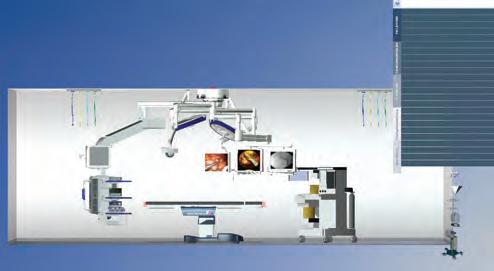
The minimally invasive surgery program provides important benefits to our animal patients: less pain, quicker recovery and less risk of infection. Shelter animals
brought to Penn Vet for free spay and neuter procedures will benefit from this state-of-the-art procedure, as well.
The suite will include equipment booms and audio/visual technology to provide clinical data and images for viewing and sharing from within the sterile field to local and remote displays. This feature allows surgeons to access instant, in-house second opinions and expertise, ensuring the ultimate in patient care. Expected completion date for this suite is Summer 2011.
The George D. Widener Hospital for Large Animals at New Bolton Center, constructed more than 40 years ago, is outdated and needs to be updated to keep pace with developments in veterinary medicine as well as the expertise of our clinicians and demands of our students. It is insufficient and unsophisticated by today’s standards.
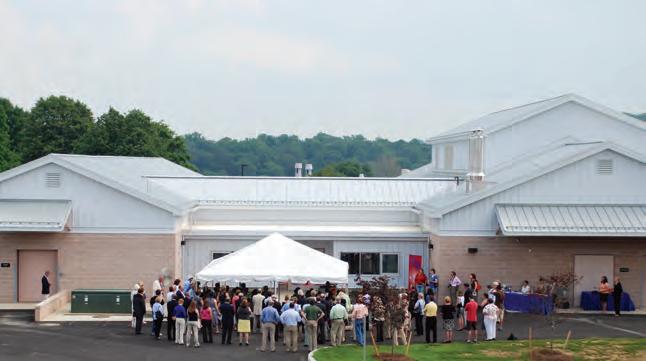
To address that problem, a state-of-the-art surgical suite upgrade is planned. The design for this suite include construction of three separate surgical rooms, a colic work-up room, three separated prep rooms, a scrub room, a faculty/staff lounge and three faculty offices. To date, $3.2 million has been raised toward the estimated total cost of $17 million.
By offering a bigger, better setting for surgeries with the most advanced equipment available, New Bolton Center and Penn Vet can continue to offer top-rate education to students and opportunities to surgeons as well as more services to clients.
In Philadelphia, customer service takes precedence with plans to create a more open, friendly and customerfocused renovation of the Ryan-VHUP lobby Currently, Hospital leadership is working to select a
An artist’s rendering of plans for the state-of-the-art minimally invasive suite slated to open in 2011 at Ryan-VHUP. Illustration by Berchtold Corporation.design firm for the project and aims to secure renderings and illustrations and begin construction this coming spring with a completion date of Fall 2011.
Proposed renovations of these 5,000 square feet of space include the addition of automated front doors for ease of entering with injured or sick animals; improved client services areas; private consultation areas in the beautified and brightened waiting area; access to an outpatient pharmacy and retail and display areas.
To date, Penn Vet has raised nearly $12 million of its $20 million goal to support students. Most of this money is for scholarship purposes, which help to alleviate the very real stress of paying back student loans after graduation.
In addition, these funds help to expand opportunities for students – nationally and internationally – and include externships, internships and valuable summer travel trips that round out the classroom curriculum. All students at Penn Vet have opportunities to travel abroad (which you can clearly see throughout this issue of Bellwether) where they engage and take on leadership roles on a global scale.
Thanks to funds already received, we’ve welcomed 125 students for the Class of 2014 and three new VMD/PhD students. The VMD/PhD program, which currently has 28 enrolled students, is one of four top programs offered in the United States and Penn Vet’s program is considered to be the most prestigious and competitive of those offered.
A hallmark of Penn Vet, faculty continue to be the best in veterinary education and are leaders in their fields. They are regularly asked to speak at international conferences and are sought-after experts.
Of the more than $4 million that’s been raised to date in this area, $3 million has been designated to endow a professorship in honor of Dr. Dean Richardson, chief of Large Animal Surgery at New Bolton Center. The gift, from generous Penn Vet friends Mr. and Mrs. Roy Jackson, is the cornerstone of a major new Penn Vet initiative to fight laminitis, which afflicted Kentucky Derby winner Barbaro. Laminitis is a severe, painful condition in horses that can be fatal. The laminitis initiative will foster training programs and studies for new treatments of equine diseases.
In addition to this professorship, $923,000 was raised to support the Harriet Woodward Professorship in Biochemistry and $420,000 was secured from Abaxis for a Ryan-VHUP Special Species term chair.
By meeting the $18 million professorship goal, we will be poised to continue to offer opportunities for these
leading researchers and teachers and maintain our firstclass reputation. Plans for money raised include looking at opportunities to endow chairs in four key areas, including neuroscience, infectious disease, regenerative medicine and cancer with emphasis on translational medicine in all areas. We also seek to secure additional named chairs in Pathobiology and Clinical Research.
Since 2006, research dollars brought in from private foundations and corporations, excluding federal and NIH grants, total $29 million, exceeding our $15 million goal by 99 percent. Penn Vet researchers have long been leaders in securing private funding for their research endeavors. Of the 28 veterinary schools in the United States, Penn Vet receives the largest share of NIH funding annually; NIH is especially interested in what we do because of our translational relationship with human medicine researchers.
While the success in fund-raising for research has exceeded our $15 million goal, we are consistently striving to expand these dollars because it allows Penn Vet faculty and staff to find new methods of treating devastating diseases and illnesses, which may ultimately better the lives of both animals and humans.
Finally, operating support to assist with the day-to-day management of both campuses is always needed. We’ve attained about 77 percent of our campaign goal in Meeting Current and Future Needs, which covers such things as operating costs, supplies and other charges. This area of our fund-raising goal is so important as it provides the tools with which faculty, staff and students work.
We are extremely grateful for the unyielding support of our friends and supporters without whom these great strides would be impossible. Two years remain in our campaign, and we hope during that period to aggressively work toward fulfilling the needs and projects outlined above. We are focused and optimistic and know that we can rely on you to help us reach these lofty aims.
For more information about how you can support our faculty and students, allow patients to receive the most advanced care available anywhere, contribute to finding a cure for the most devastating diseases and illnesses in both animals and humans and ensure public health, contact Melissa von Stade, assistant dean of Advancement, Alumni Relations and Communications for Penn Vet, at mstade@vet.upenn.edu.
Mammary gland tumors are the most common tumors in intact female dogs and represent a common cause of disease and premature death.
Pet overpopulation is a problem, especially in shelters where many dogs may develop mammary tumors. without proper treatment these dogs may be difficult to adopt out.
Ryan-VHUP has the expertise to care for these dogs through the Canine Mammary Tumor Shelter Program.
Both Dr. Karin Sorenmo and Dr. Michael Goldschmidt, head of Surgical Pathology, have an interest in these canine tumors and, in collaboration with Dr. David Holt, head of Surgery, and Dr. Michael Moyer, V’90, director of Penn Vet’s Shelter Medicine Program, offer a highly qualified team to care for these dogs.
with treatment, the team collects clinical and biological information about mammary tumor development.
Previous studies have identified similarities between canine mammary tumors and breast cancer in women in terms of epidemiology, biology, dietary risk factors, clinical behavior and hormonal association.
Canine mammary tumor development is dependent on exposure to ovarian hormones – a risk that can be reduced by performing early-age spays.
women’s risk for developing breast cancer is also associated with cumulative exposure to bioavailable estrogens, suggesting that similar hormone-driven mechanisms might be linked with breast carcinogenesis in both species.
Note: Penn Vet is collaborating with Dr Olga Troyanskaya, assistant/associate professor in Cancer Bio-informatics, Department of Computer Science and Lewis-Sigler Institute for Integrative Genomics, University of Princeton.
Krista Buerger brought her family’s Portuguese Water Dog, Kobe, to the Matthew J. Ryan Veterinary Hospital at the University of Pennsylvania (Ryan-VHUP) because she knew something was wrong. Kobe had become lethargic and he wasn’t eating.
It was Christmas night in 2008. And the dog was diagnosed with lymphoma – a devastating diagnosis for Krista and her family.
After deciding to do all they could to extend Kobe’s quality of life, Krista and her husband Reid opted to have Kobe treated with chemotherapy, an ongoing treatment that required several repeat visits to Ryan-VHUP. But the Buergers didn’t mind. They wanted what was best for their Kobe and were impressed by the experts taking care of the dog.
“When you’re at Penn Vet, you can feel the passion that every member of the staff radiates,” said Krista, who later became a member of Penn Vet’s Board of Overseers. “Everything we experienced at the hospital was incredibly impressive.”
While there waiting for their beloved Kobe to finish up his regular treatments, the Buergers learned about Dr. Karin Sorenmo, chief of Medical Oncology at Ryan-VHUP, and her work in cancer research. The Buergers’ interest was piqued, and, after delving a little deeper into the details of what Dr. Sorenmo’s cancer research included, they decided to help establish the Penn Vet Canine Mammary Tumor Shelter Program with a generous leadership gift from the Buerger Family Oncology Research Fund and the Kobe Buerger Oncology Resident Fund.
“We decided to give to this research area because of our experience with Kobe’s cancer treatment and because I have a family member who is a breast cancer survivor,” said Krista. “But it’s more than that. Once you get to know Penn Vet, you want to be able to give back and play a part in supporting its efforts.”
The Penn Vet Canine Mammary Tumor Shelter Program aims to provide highquality care to homeless dogs in shelters that do not have access to the care they need to survive or find homes. At the same time, the program allows Dr. Sorenmo and her colleagues to continue advancing research on the biology of mammary tumors in dogs, which, in turn, has implications for advancing research of breast cancer in human patients.
In January, 2010, just one year after learning of Kobe’s lymphoma diagnosis, the beloved Portuguese Water Dog succumbed to the disease. And while Kobe is survived by three other PWDs owned by the family (Uni, age 8; Wilson, age 4; and Palmer, age 2), his life provided a lasting legacy for Penn Vet, its researchers, students and other clients working through the difficult process of dealing with a pet with cancer. And it’s because of the Buergers’ forethought, insight and generosity that the program has had success in its first year of operation.
“We’re glad we can play a part in keeping Penn Vet the fabulous resource that it is,” said Krista.
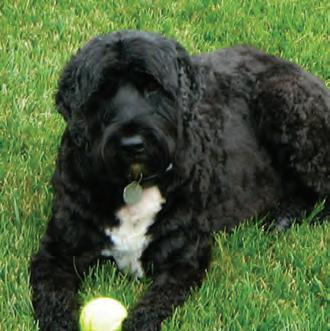
Your contributions play a critical role in our ability to serve the citizens and animals living in Pennsylvania and beyond. I thank you all for your support, and I hope we can count on your continued investment in the University of Pennsylvania School of Veterinary Medicine for years to come.
The following are gifts totaling $150 or more that were made to the School of Veterinary Medicine between July 1, 2009 and June 30, 2010.
in honor of a special person or pet
Mr. & Mrs. Frederick R. Adler in honor of Dr. Rebecka
S. Hess and Dr. David Holt and
Steven w Atwood, VMD, MD in honor of Joan C. Hendricks, VMD, PhD
Mrs. Barbara R. Cannon in honor of Ossie
Henry L. Croft, Jr., VMD in honor of Henry, Sr. & Jimmie Croft
Sharon A. Dailey, VMD in honor of Joan B. O’Brien, VMD
Mr. Rick Elbaum & Ms. Abby Elbaum in honor of Dr. Kristin walker & Dr.Alex Reiter
Mr. and Mrs. Alan J. Fishman in honor of Danielle and Lauren
Dr. Henry Gasiorowski & Dr. Michele Gasiorowski in honor of Janik & Brooke Gasiorowski
Glenn P. Gillard, VMD in honor of Charles w Raker, VMD
Dr. Colin E. Harvey in honor of Paul Berg
Mr. and Mrs. Robert P. Heidenberg in honor of Mindy Heyer
Dean Joan C. Hendricks & Mr. Anthony Garvan, Jr. in honor of Kate Judge, Tom Van winkle, Phil Scott and the Penn Vet Staff
Dr. Allen Judman in honor of Dr. David Holt
Howard E. Markle, Jr., VMD in honor of Class of 1980
Mrs. Joanna Milstein in honor of Ms. Abby Elbaum
Edward M. Mimnagh, VMD in honor of Dean Mark Allam
Mr. G. Robert Overhiser, Jr. in honor of Sarah wells Overhiser
Barbara E. Penney, VMD in honor of Margaret L. Petrak, V’52
Dr. Petra B. Ramirez in honor of Dr. Juan L. Ferrer
Dr. and Mrs. Desmond J. Reilly in honor of Nancy K. Reilly, VMD
Mr. and Mrs. Larry A. Thaxton in honor of Dr. George Myatich
Mr. & Mrs. Steven Zarmsky in honor of Mr. Mrs. John Hangen
in memory of a special person or pet
Mr. & Mrs. Francis Abbott in memory of Mr. Peter w wether ill
Linda E. Aiken, VMD in memory of Anna E. wor th, VMD
Dr. Francis T. Ashton in memory of Gerhard A. Schad, PhD
Jill A. Bailey, VMD in memory of Sarah
Joel R. Bigger, VMD in memory of Francis J. Bertozzi, Jr., VMD
Bernard F. Brennan, VMD in memory of Florence Brennan
Mr. Kenneth A. Ciolli in memory of Mr. Peter w wether ill
Mr. & Mrs. Michael Clothier in memory of Erin
Ms. Victoria Depalma in memory of Augusta
Mr. and Mrs. Thomas Domencich in memory of Mr. Peter w wether ill
Barbara Eisen, VMD in memory of Rita
Dr. & Mrs. Joseph Fecher, Jr. in memory of winnie
Ms. Dorothy S. Fryer in memory of Taffy Fryer
Rebecca Garabed, VMD in memory of Boots and Buddy
Glenn P. Gillard, VMD in memory of Dr. Sliced
Lillian A. Giuliani, VMD in memory of Yang
 B Y S U SAN M I LLER
B Y S U SAN M I LLER
since Penn Vet’s inception more than 125 years ago, the generosity and support of many good friends has sustained our School and assured our future. These friends – donors, clients, alumni, students, faculty, animal lovers and more – give of their time and their talents. They entrust us with the care of their animals. And many dig deep to help us meet our financial needs.
Some friends find more creative ways to support Penn Vet and our mission of education, research and service.
When school is out, the homework is set aside and extracurricular activities are on hiatus, how might four young ladies in Philadelphia fill their long, summer days? By setting up a lemonade stand and selling ice-cold lemonade to thirsty friends, neighbors and passersby.
That’s exactly what Rachael and Emma Hunter, Teagan and Maggie Kirby and Leah Graham all did one warm summer day. At the end of the day, these entrepreneurs donated their profits to the Matthew J. Ryan
Veterinary Hospital at the University of Pennsylvania (Ryan-VHUP) to help sick pets.
Rachael and Emma’s father is Dr. Christopher Hunter, chair of Penn Vet’s Pathobiology Department. Entrusted with the girls’ profits, he brought their donation to the Development Office where the dollar bills and coins were credited to the Friends of Ryan Hospital Fund. The girls were very happy to learn that their gift helped us treat not only dogs and cats but birds, reptiles and fish.
After their generous donation, the girls came to campus to tour the place they had helped and to get a first-hand look at the hard work their donation allows our veterinarians to do. Of particular interest on the tour were the feline kidney donors, where the five spent much of their time with Lynne Beale, a renal transplant nurse, and the cats, giving plenty of thankful snuggles to these heroic felines.
Shortly before Thanksgiving in 2008, Maryjo Smith of Allentown, PA got the news no pet owner ever wants to hear: Her dog Bruiser had been diagnosed with hemangiosarcoma, an aggressive and common cancer in dogs that originates in the endothelium (the lining of blood
continued on page 24
Alan S. Glassman, VMD in memory of Leon Glassman
Tamar B. Goldstein, VMD in memory of Gwen Fernich, VMD
Griffiths Construction, Inc. in memory of Mr. Peter w wether ill
Dr . Nancy Haiko in memory of Rainbow Yarnall
Mrs. Dorrance Hill Hamilton in memory of Mr. Peter w wether ill
Elaine P. Hammel, VMD in memory of Dr. Adelaide Delluva
Peter H. Herman, VMD in memory of Terry Herman
Ms. Jennifer w Hudson in memory of Francis “Frank” Bertozzi, Jr.
Susan Irene Jacobson, VMD in memory of J.L. Jacobson & H.V. Plunkett
Ms. Margo L. Jones in memory of Eight Bells
Dr. Allen Judman in memory of Zeke
Mr. and Mrs. Clayton G. Kilrain in memory of Katie
Mrs. Krystyna Z. Knight in memory of Dr. David Knight
H. Michael Maetz, VMD in memory of Henry and Anne Maetz
Mrs. Mary Alice D. Malone in memory of Mr. Peter w wether ill
Jeanine Louise Mantione, VMD in memory of woody and Chloe

Ms. Janet P. Mead in memory of Timothy J. Mead
Holly B. Mehew, VMD in memory of Shadow Carey
Jonathan E. Meincke, VMD in memory of Clark Rodney Dickson, Edward Barnett, Jr. and Lester Barto
David A. Meirs II, VMD in memory of Dr. Robert Kenny
Ms. Katherine E. Migrala in memory of Rex
Mr. James L. Miller in memory of Rick
Mrs. Elizabeth R. Moran in memory of Mr. Peter w wether ill
Susan D. Morgan, VMD in memory of Anna wor th V’78
Deborah S. Patt, VMD in memory of Dr. John F. Patt
Mr. Bruce Peterson in memory of A. wayne Mountan, VMD
Ms. Susan A. Phillippe in memory of Brickey, Gaby, Danny and Cody
Dr. and Mrs. Michael C. Saltzburg in memory of Bretton
Patricia A. Schweibenz, VMD in memory of Sammy Shoettler
Mr. and Mrs. Joseph J. Sertich in memory of Joseph Sertich, III and Richard J. O’Brien
Mrs. P. Jane Simone in memory of Mr. Peter w wether ill
Ms. Kajsa M. Thompson in memory of Flicka Thompson
Dr. & Mrs. Max A. Van Buskirk, Jr. in memory of George Franks V’56
Ms. Mary Ann Vierheilig in memory of Lady, Muffin & Binky
Ms. Diana S. wister in memory of Mr. Peter w wether ill
Mr. and Mrs. Keith B. Yantes in memory of Pepper (Pep) & Splat
Mr. & Mrs. Steven Zarmsky in memory of Brinkley
The following have made gifts to the Penn vet memorial fund in memory of francis J. bertozzi, Jr., v m d
Mr. & Mrs. Mark S. Baran
Stephen Thomas Bartlett, MD
Ms. Kim Berger
Ms. Ashley L. Block
Mr. & Mrs. Thomas C. Burke
Mrs. Katharine A. Foard
Ms. Chantal M. Fogarty
Mr. Timothy J. Gilmore
Ms. Joan Guliere
Ms. Emily F. Hammond
Mrs. Helen M. Heidelbach
Mr. & Mrs. Joseph A. Hosier
Ms. Mary J. Kleinsmith
Mr. Ronald J. Klemkowski, Esq.
Ms. Andrea LeMatta
Mrs. Patrice C. Morrison
Thomas F. & Clementine Mullan Fdn.
Ms. Diane R. Procter
Ms. Anna Reier
Roseline Financial Group, LLC
Mr. & Mrs. Simeon Schlossberg
Ms. Ann M. Schultz
Ms. wendy L. Sheckells
Mrs. Lois Stuart
Mr. & Mrs. Edmund F. Thompson
Mr. & Mrs. Michael J. Torppey
Ms. Laura warfield
Ms. Karen E. Zukas
The followiNg gifTs were made To The veTeriNary sTUdeNT scholarshiP fUNd
in honor of a special person or pet
Mr. & Mrs. Fred Askin in honor of Dr. Ed Molesworth
Andrew J. Breslin, VMD in honor of Donald C. Kamslor, VMD
Ramsay S. Buchanan, VMD in honor of Dr. Robert Flowers
Dr. Richard L. Davidson in honor of Dominic Dallago, VMD
Mr. & Mrs. Paul F. Fischer in honor of Salvatore
Philip R. Hunt, VMD & Cynthia Ann Hunt, VMD in honor of Robert M. Kenney
Ms. P. J. Lease in honor of Victoria Johnson, VMD
Dr. David Johnson & Dr. Barbara Smith in honor of Charline S. Russo
H. Steven Steinberg, VMD in honor of Sheldon Steinberg, VMD
in memory of a special person or pet
Paul K. Adolf, VMD in memory of Thomas S. Osborne, VMD
Mr. & Mrs. Fred Askin in memory of Connor
Jennifer H. Brownhill, VMD in memory of James C. Brownhill
Joseph H. Groveman, VMD in memory of Lynn Groveman, Mervin D. Groveman, VMD and Sue A. Groveman
Ms. P. J. Lease in memory of Baby
Dr. John McGuire & Dr. Lynn Lawrence in memory of Harvey Bier
Patricia M. McManus, VMD, PhD in memory of M. Josephine Deubler
Ms. Alice S. Moyer in memory of FC Shadach’s Maghogany Chaz, Justin, Maddie and Rocky
Mrs. Elizabeth Rudy in memory of John w Rudy
Dr. Jeffrey Salatiello & Dr. Mary-Beth Hamorski in memory of Peter Salatiello
Linda waltz Schaffer, VMD in memory of Dr. Harvey C. waltz
Mar got Beth Schwag, VMD in memory of Roland Fuhrman
Thomas w Shoemaker, VMD in memory of Harry L. Schultz, Jr. VMD
Eugene P. Steffey, VMD in memory of Russell S. Detwiler, VMD
Jon A. Stokes, VMD in memory of John Knochel, V’67
The following gifts were made to the m. Josephine deubler scholarship fund
Bucks County Kennel Club in memory of Mary Ann Young
Mr. and Mrs. Richard D. Trimpi in memory of Josephine Deubler, VMD, PhD
Mrs. Helma weeks in memor y of Josephine Deubler, VMD, PhD, Mr. Gilbert S. Kahn and Strombi
The following gift was made to the Jay Jasan endowed scholarship fund in memory of Jay Jasan, v m d
Mr. Joseph Barone & Ms. Debra E. Lembeck
The following gifts were made to the schad summer fellowship fund in memory of in memory of gerhard a schad, Ph.d
Dr. Jay P. Farrell
Mark E. Haskins, VMD PhD
Dr. Christopher Hunter
Ms. Margaret Mulqueen-Schad
Dr. Thomas Van winkle & Dr. Mattie Hendrick
The following gift was made to the vet class of 1968 endowed scholarship fund
Maron Calderwood Mays, VMD, PhD in memory of Kenton S. Stokes, VMD
The following gift was made to the vet class of 1977 endowed scholarship fund
Edward A. Donaldson, VMD in memory of Dr. Clark Dickinson
The following gifts were made to the vet v m d./Ph.d scholarship fund
Patricia M. McManus, VMD, PhD in honor of Dr. Michael Atchison
Mark J. Pykett, VMD, PhD in honor of Donna George
continued from page 23
vessels and spleen). Sadly, Bruiser, a shepherd-mix, had a few short weeks before his illness took his life. Devastated by the loss of her good friend and long-time running companion, Maryjo vowed to do something about it.
The result was the inaugural Bruiser Memorial 5K Run held along the Lehigh-Allentown Parkway on September 12, 2009.
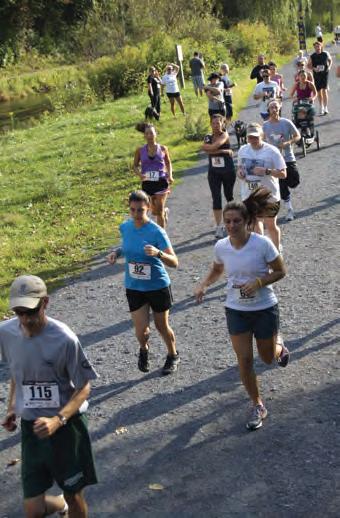
An avid runner, Maryjo had participated in many races but being the sole organizer of the Bruiser 5K was a new experience. Marketing the race, coordinating a timing system, managing entries and fees, asking for donations of ice and water, plus hundreds of additional details consumed her free time for the better part of the year.
On race day, her efforts paid off. More than 100 runners came out on a drizzly morning to hit the pavement. Some came just to run, but many came because they had something in common with Maryjo: They had also lost a beloved pet to cancer.
In the end, Maryjo’s tireless commitment in Bruiser’s memory raised $8,000, which she generously directed to Penn Vet’s study of cell-based cancer vaccines led by Dr. Nicola Mason.
Her second-year at the 5K run was even more successful. Held on September 25, Maryjo’s efforts paid back nearly three-fold with a total donation of more than $20,000, which, again, she donated for Dr. Mason’s research.
Another good friend of Penn Vet is Dr. Christopher Anastasiou, ophthalmologist and owner of The Modern Eye, two boutique eye glass stores in Philadelphia. In addition to being a Penn Vet donor for a decade, Dr. Anastasiou’s dogs have been clients at Ryan-VHUP.
Like Maryjo, Dr. Anastasiou has lost a dog to cancer. He knows all too well that although there are new treatments that may prolong the life of a pet for a short time, cancer, in the end, is a devastating disease.
If you visit Dr. Anastasiou’s Walnut Street store on the Penn campus, you’ll find a big piggy bank on the counter. Next to it is a photograph of his two dogs, Buddy and Lucky, with an invitation to make a donation to support canine cancer research at Penn Vet.
As the piggy bank is filled up by patients and visitors to the store, the money collected is donated to Penn Vet and the Canine Cancer Research Fund. This fund supports research projects at Ryan-VHUP and encourages our veterinarians, veterinary students, interns and residents to engage in clinical investigations of various forms of cancers with which patients present.
Working from the heart, each of these wonderful friends found a non-traditional way to support Penn Vet and the work of our veterinarians, researchers and students.
It is through both traditional and non-traditional support that Penn Vet is able to lead the way in developing new treatments, build state-of-the-art clinical facilities, continue essential and necessary research of diseases that affect both animals and humans, attract and retain the highest caliber of faculty, staff and students and help future veterinarians fund their education and training.
If you are interested in learning how you can support Penn Vet’s students, research and clients, please contact Melissa von Stade, assistant dean of Development, Alumni Relations and Communication, at 215-898-1480 or mstade@vet.upenn.edu.
The followiNg gifTs were made To veTeriNary oPPorTUNiTy scholarshiP fUNds
in honor of a veterinary student
Jeffrey Bowersox, DVM in honor of Cathleen DeBenedictis, V’11
Centre Equine Practice in honor of Kathryn Abrahmsen V’11
Mark A. Cofone, VMD in honor of Cathleen DeBenedictis, V’11
James F. Geer, VMD in honor of Nathan Kapp, V’11
Lillian A. Giuliani, VMD in honor of Anya Valdes-Dapena, V’11
D. Ray Hostetter, VMD in honor of Melanie Hnot, V’10
Mr. Robert w Huffman in honor of Jessica Fragola, V’11
Dr. Kristin Jankowski & Dr. Arthur Jankowski in honor of Cathleen DeBenedictis, V’11
John w Lee, Jr., DVM & Mary Jane Fassinger, VMD in honor of Emily Schaefer V’11
E. Scott McAllister, VMD in honor of Kathryn Abrahmsen V’11
Dr. Michael Miller & Dr. Robin Scheiner in honor of Cathleen DeBenedictis, V’11
Sara Ann T. Moran, VMD in honor of Eric Dibble, V’13
Dr. & Mrs. Scott Palmer in honor of Amy Santonastaso V’11
Dr. & Mrs. James Reid in honor of Kristina Simone V’11
Kenton D. Rexford, VMD in honor of Emily Morse V’11
Dr. Dean w Richardson and Dr. Laura Richardson in honor of Deanna Pie V’10
Gary Edward Rothman, VMD in honor of JoEllen Bruinooge V’11
H. James Schroll, VMD & Jane S. Schroll, VMD in honor of Lauren Sechler V’11
Mead F. Shaffer, Jr., VMD in honor of Dan Abbott V’11
Thomas V. Sollas, Jr., VMD in honor of Kate McIntyre V’10
James V. Stewart, VMD & Brenda Lewis Stewart, VMD in honor of Chaundra Schofield V’11
Amos w Stults, Jr., VMD in honor of Melanie Hnot, V’10
Marilyn B. weber, VMD in honor of Melonie Sappe, V’10
Yergey Stewart Vallance & Associates in honor of Abby Shearin, V’10
in memory of a special person or pet
Ms. Sarah A. Boice in memory of Maggie
Mr. and Mrs. James M. Cummings in memory of Dr. Robert M. Kenney
Mrs. Birthe Detweiler in memory of David K. Detweiler, VMD
Ms. Barbara Doubman in memory of St George Hunt, VMD
Fred Fernich, VMD in memory of Gwen Fernich
Barbara D. Forney, VMD in memory of Dr. Robert M. Kenney
Dr. Robert C. Forney & Ms. Marilyn Forney in memor y of Dr. Robert M. Kenney
Dr. & Mrs. Charles C. Love in memory of Dr. Robert M. Kenney
Mr. Gary Benjamin Lowitt in memory of Gwen Fernich
Ms. Linda Mahan in memory of Maggie
Ms. Susan Robinovitz in memory of St George Hunt, VMD
Mrs. Laura Simpson Thorn in memory of Dr. Robert M. Kenney
The followiNg gifTs were made To New bolToN ceNTer in honor of a special person or pet
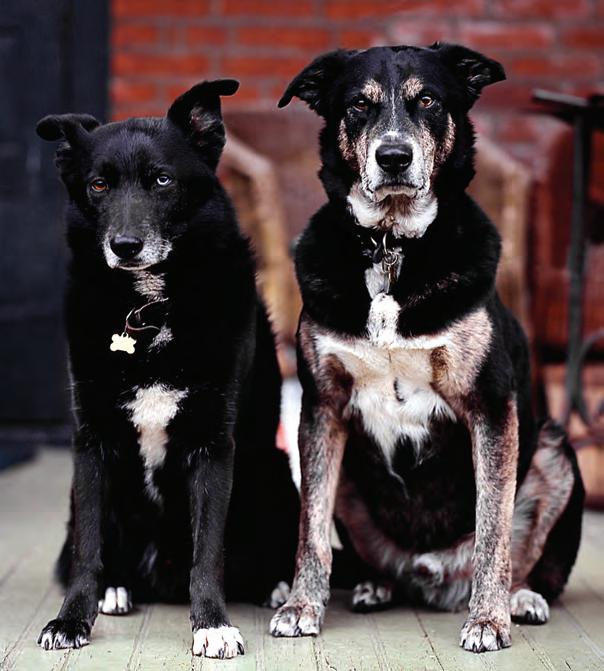
Mr. Colin Atkins in honor of Unlimited Bud Chevron Corporation in honor of Dean w Richardson, DVM
Ms. Lolly Clarke in honor of Dr. Ben Martin
Dr. & Mrs. Richard Davies in honor of Gary Althouse
Dr. & Mrs. william L. Elkins in honor of Field Service
Mr. and Mrs. Kenneth J. Feld in honor of Dr. Midge Leitch
Ms. Jan Handtmann in honor of Remember Me & Dr. Krauss
Ms. Jacqueline B. Mars in honor of Christa Schmidt
Mr. and Mrs. Arthur P. Pasquarella in honor of Just A Rumor
Ms. Sarah E. Reese in honor of Bart
Dr. Carolyn Carruth Rizza in honor of Storm Harbor
Ms. Jessica M. Sinnott in honor of Mr. and Mrs. John P. Sinnott
Max L. Sponseller, VMD in honor of Charles w Raker, VMD
Mr. & Mrs. David Tranquillo in honor of Gina Tranquillo, VMD
Cuyler Harriman walker, Esquire in honor of Averell Penn Smith walker
Ms. Betty E. williford in honor of Dean w Richardson, DVM
in memory of a special person or pet
Mrs. wilhelmina M. Austin in memory of wise Talk
Mr. & Mrs. Steve Biedenbach in memory of Tchin - Tchin Biedenbach
Ms. Candice C. Brown in memory of Andrew C. Colando, VMD
Ms. Barbara Brungess in memory of Trevrizent
Ms. Julia Bruno in memory of Peek - A - Boo
Dr. and Mrs. Daniel Cohen in memory of Mark w Allam, VMD
Adam C. Colando, Jr., Esq. in memory of Andrew C. Colando, VMD
Mr. Adam C. Colando in memory of Andrew C. Colando, VMD
Ms. Irene Colando in memory of Andrew C. Colando, VMD
Ms. Sophie Du Pont in memory of Beacon
Mr. and Mrs. Gordon R. Farquhar, Sr. in memory of Spy
Ms. Brenda Fessler in memory of Raven
Mrs. Sharon Journey in memory of Grayson
Ms. Rebecca L. Julian in memory of Tiddly winks
Jean M. Lasser, VMD in memory of Neal C. Ralston, VMD
Dr. Burton Mark in memory of Zenith
Ms. Shirley M. McEnnis in memory of Scott McEnnis
Mr. wills Passmore in memory of william Boucher
Ms. Susan A. Phillippe in memory of Danny
Mr. Kerry N. Hitt & Jeanne L. Van Nuys-Hitt, VMD in memory of Ina H. Van Nuys
The following gift was made to the m lynn sammons award in bovine medicine
Dr. Lenora Sammons & Mr. Howard Sammons in memory of Dr. M. Lynn Sammons
The following gift was made to the reef research fund
Ms. Lolly Clarke in honor of Marions Butler’s Birthday
The following gift was made to the dean richardson Professorship in equine disease
Mr. & Mrs. M. Roy Jackson, Jr. in honor of Mrs. Gretchen S. Jackson
The following gift was made to the george d widener hospital surgical suite fund
Mrs. Beverly Ensor in memory of James Simpler, Lawrence E. Ensor and Mr. Peter w wether ill
The following have made gifts to the laminitis research fund in honor or in memory of a special pet or person
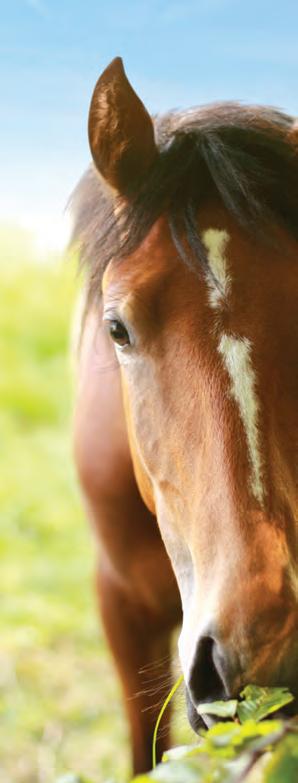
Mrs. Deborah Anderson in honor of Dr. Dean Richardson
Ms. Kathy L. Breakall in honor of Dr. Dean Richardson’s birthday
Ms. Mary Beth Drobish in honor of Dr. James A. Orsini
Mrs. Margaret H. Jordan in honor of Martita Goshen and Dr. Dean Richardson’s Birthday
Ms. Margaret Anderson Luckett in honor of Dr. Dean Richardson & the staff at New Bolton Center
Mr. and Mrs. David M. Mickelson in memory of Hamlet
Mr. Robert w Peters in honor of Kip Deville
Miss Susan J. Puleo in honor of Dr. Dean w Richardson and Dr. Laura Richardson
Mr. Harold Via in honor of Goodnight Shirt
Ms. Linda walker in memory of Secretariat
Mr. Bret M. whitaker in honor of Arbor Mist Farms, Baltimore,OH
The following have made gifts to the barbaro gift fund in honor or in memor y of a special pet or person
Ms. Mary K. Adams in honor of Dr. Dean Richardson’s birthday
Dr. Patricia A. Assan in memory of Hobo and Oliver
Mr. & Mrs. Steve Biedenbach in memory of Tchin-Tchin
Ms. Jeri L. Callaghan in honor of Dr. Dean Richardson’s Birthday
Mr. & Mrs. Steven w Concannon in memory of Kelly
Mr. Martin J. Fischer & Ms. Karla J. Fischer in honor of Dr. Richardson’s and Karla J Fischer’s Birthday and in memory of Leonard Goss
Mrs. Helen K. Groves in honor of Mrs. Gretchen Jackson
Mr. Mitchell H. Herzog in memory of Renne Herzog
Ms. Andrea R. Hilliard in honor of Dean Richardson
Mrs. Margaret H. Jordan in honor of Martita Goshen
Ms. Mary Remondini in honor of Dr. Dean Richardson’s Birthday
Ms. Linda walker in honor of Dr. Dean Richardson
The following have made gifts to the barbaro, laminitis research and friends of New bolton center funds in memory of barbaro
Mrs. Amy S. Abbott
Ms. Mary K. Adams
Mrs. Deborah Anderson
Dr. Patricia A. Assan
Ms. Penny Austin
Ms. Jean Bartsch
Mr. & Mrs. Steve Biedenbach
Ms. Kathy L. Breakall
Ms. Julia Bruno
Butler Pappas weilmuller Katz, Craig LLP
Ms. Jeri L. Callaghan
Ms. Teresa A. Callahan
Ms. Vera Conwicke
Ms. Mary Copelin
Ms. Ruth M. Coutu
Mrs. Barbara DiBona
Ms. Jackie Dolan
Ms. Sharon A. Errickson
Mr. Martin J. Fischer & Ms. Karla J. Fischer
Ms. Nancy Fisher Blinkhorn
Mr. and Mrs. Kim B. Franzoni
Friends of Barbaro
Mrs. Jamie L. Gillispie
Ms. Donna J. Gruber
Mr. Edward G. Healey
Ms. April Jackson
Ms. Margo L. Jones
Mrs. Margaret H. Jordan
Alan D. Longman, Esq.
Ms. Margaret Anderson Luckett
Ms. Mary Alice Lucot
Dr. Sierra A. Moulton
Ms. Virginia L. Nadler
One Horse at a Time, Inc.
Mr. and Mrs. John E. O’Neil
Ms. Melissa J. Pegram
Mr. Robert w Peters
Miss Susan J. Puleo
Dr. Linda Gerber Quest
Ms. Andrea K. Rainey
Donna Ralph, DVM
Ms. Mary Remondini
Ms. Denise A. Riccio
Mr. D. L. Robertson
Mrs. Susan Scaperotto
Ms. Karen C. Schwenk
Ms. Jo Lauren Seavy
Ms. Gina G. Smith
Miss Janis A. Sutton
Sandra Switzer
Mrs. Anita L. Ulishney
Ms. Linda walker
Mr. & Mrs. Lawrence E. wicks
The followiNg gifTs were made To The ryaN veTeriNary hosPiTal
in honor of a special person or pet
Mr. & Mrs. Timothy B. Barnes in honor of Kimo and Keoki Barnes
Dr. Ronald I. Boss & Ms. Ruth Thomas Boss in honor of Carolyn Mitchell and the Ryan Oncology Doctors & Nurses
Ms. Karen Bossert in honor of Dr. Chick weisse
Mr. & Mrs. wIlliam Bricker in honor of Jan
Mr. Gary Brown in honor of Peggy Brown
Mr. & Mrs. william S. Browne in honor of Kathryn and Arthur Foran Buckingham Animal Hospital in honor of wer ner K. Margenau, VMD
Ms. Mary A. Campomenosi in honor of Bond
Ms. Nancy Magness Carr in honor of Kevin Coogan
Mrs. Carolyn R. Cotter in honor of Dr. Lesley King
Dr. & Mrs. Richard Davies in honor of Donna Oakley, Dr. Dorothy Cimino Brown, Dr. Kathy Michel, Dr. Mark Oyama, Dr. Rebecka S. Hess, Dean Joan C. Hendricks and Ms. Maureen Harrigan
Mr. Clyde Hart & Dr. Betsy L. Dayrell-Hart in honor of Dr. Sheldon Steinberg
Mrs. C. Ann Degler in honor of Logan, Quinn, Darkess
Mr. & Mrs. Barry Doohan in honor of Dr. Sorenmo & the Oncology Surgical Dept.
Mr. & Mrs. Neil E. Fasnacht in honor of Edward M. Mimnagh, VMD, Margaret Mimnagh and Staff
Ms. Lisa A. Ferrarain honor of Allison St. John, Dr. John Lewis & Dr. Robert Menzies
Victor Ferrari, MD & Ms. Christine Cortese-Ferrari in honor of Dr. Meg Sleeper
Mr. & Mrs. Fred in honor of Sophie & Cagnie
Ms. Susan Gabriel in honor of Amber, Jade, Pearl and Opal
Mr. and Mrs. Thomas w Goas in honor of Oscar
Mr. & Mrs. Clay Hamlin III in honor of Kirby
Mr. Mark Harbison in honor of Gordon Peddle, VMD
Mr. Michael L. Hathorne in honor of Dr. John Lewis
Ms. Margaret S. Havens in honor of Heidi
Dean Joan C. Hendricks & Mr. Anthony Garvan, Jr. in honor of Ryan Business Office
Mr. Miles w Stein & Ms. Nancy Jeffries in honor of Peter, Forrest, Dr. Laura Hoyt, Lillian E. Duda, VMD & Lillian R. Aronson, VMD
Mr. James Koch in honor of Dr. Chick weisse
Br adford Y. Kube, VMD in honor of wer ner K. Margenau, VMD
Adelaide Diane Kuhn, VMD in honor of wer ner K. Margenau, VMD
Ms. Marina D. Liem in honor of Frisky
Ms. Susan Master in honor of Sophie
Ms. Rosalie G. Matzkin in honor of Quinby, Coach, Leila and Nate
Ms. Cathy A. Mazur in honor of Peanut
Mrs. Marian Mills in honor of Shiloh, Madison, Dana, Demelga, & Mystery
Ms. Daphne M. Neveras-Lupfer in honor of Shelby, Ranger & Bailey
Mr. & Mrs. Michael Ney in honor of Drs. Mike & Lila Comalli
Mr. & Mrs. Cornelius O’Brien in honor of Casey O’Brien
Ms. Cindy Jo Pauley in honor of Shadow & Trooper
Mr. & Mrs. Mark Promislo in honor of Samantha
Ms. Deborah A. Resnick in honor of Pat winters
Ms. Lori A. Rickard in honor of Charlee Rickard
Ms. Therese S. Ringkamp in honor of Penny
Joan M. Roediger-Finkelstein, J.D. in honor of Dr. Mark P. Rondeau
Dr. Pamela Rootenberg & Mr. David Springer in honor of Dr. Kerry Tupper-Hume
Mr. and Mrs. Eugene Roth in honor of Dr. Cooper and Dr. Green
Mr. Roger E. Rozsas in honor of all of the exceptional staff
Ms. Cornelia Schlotter in honor of The Bears, Honey & Baggy
Ms. Tawn J. Stokes in honor of Penn Vet & Mae
Miss Janis A. Sutton in honor of her pets
Ms. Terry R. Taylor in honor of Zoe
Joseph E. Thompson, DVM in honor of wer ner K. Margenau, VMD
Mr. Renny E. Thoms in honor of Kate
Mr. and Mrs. James. A. Torrey, Jr. in honor of Dr. Lillian Aronson & Lynn Beale
Ms. Dorothy E. walizer in honor of Stashacat
Ms. Jean B. watson in honor of Trooper
Ms. Ann C. wickliffe in honor of Admiral
Ms. Mary A. Yacovelli in honor of Snoopy
Mr. and Mrs. Thomas A. Zucca in honor of Gwyneveve in memory of a special person or pet
Paul K. Adolf, VMD in memory of Thomas S. Osborne, VMD
Mr. Vincent J. Anderson in memory of Chauncey
Ms. Nancy L. Bader in memory of winnie and Smokey
Bank of New York Mellon in memory of Augie and Jake Rogers
Ms. Julia Bruno in memory of Peek-A-Boo
Bucks County water/Sewer Authority in memory of Kathleen Smith
Ms. Nancy Magness Carr in memory of Snowy
Mr. Adrian Castelli & Ms. Mary G. Love in memory of Zach
Ms. June Claburn in memory of Roberta Ruliffson
Michele Moran Clancy, MD in memory of Trolley
Mr. and Mrs. Joseph M. Clarke in memory of Spice & L.B.K.
Ms. Reina Cohen in memory of Tiffany Grossman Cohen
Mr. Thomas C. Deas, Jr. in memory of Heidi
Mrs. Anne C. Dillon in memory of Dr. St. George Hunt
Ms. Marilyn P. Draper in memory of Ch. Gabriella DelLago
Ralph C. Eagle, Jr., MD in memory of Ewa L. Eagle, MD
Ms. Cheryl L. Eberle in memory of Penelope
Mr. David K. Erickson in memory of Bjarne and Lorraine N. Erickson
Ms. Jayne E. Graham in memory of J.J.
Mr. James E. Gregg in memory of Amber
Mr. Michael L. Hathorne in memory of Tuckerman
Ms. Elizabeth Hughes in memory of Lady Jane Grey
Mr. Miles w Stein & Ms. Nancy Jeffries in memory of Sophie
Mr. and Mrs. Keith S. Jennings in memory of Remy
Mr. & Mrs. war ren Kantor in memory of GiGi Fluffball
Ms. Pat Kassin in memory of Gizmo
Ms. Carrie Blessing Keith in memory of Molasses Keith
Mr. Albert Kerrigan in memory of Snoopy
Mrs. Dolores R. Kulp in memory of Becky Kulp
Ms. Deborah Lamb in memory of Rich & Harriett Frank
Laurel Highlands Kennel Assocation in memory of Jane Slep
Ms. Lori A. Locke in memory of Teddy
Ms. Rosalie G. Matzkin in memory of Brandy Graham and Sparky
Mr. Anderson McCabe in memory of Dexter
Dr. Gordon D. McIntyre and Dr. Gail McIntyre in memory of Rogue
Mr. Thomas McKeon & Ms. Elizabeth McKeon in memory of The Hellinger Family
Mr. and Mrs. James A. McMillan in memory of Rocky and Justice
Ms. Geralyn M. Meny in memory of Maggie
Ms. Katherine E. Migrala in memory of Rex
Dr. Sean Maguire & Ms. Margretta Milles in memory of Knapstein’s Bolo
Mrs. Marian Mills in memory of Matthew J. Ryan
Sally Fuller Mobraaten, VMD in memory of william Mobraaten
Ms. Maryjeannette J. Monihan in memory of James Monihan
Mr. Thomas Mould in memory of Pippy
Mr. and Mrs. Ronald S. Murphy in memory of Lucky Dog
Mr. & Mrs. Michael Ney in memory of Jasmine
Park East Animal Hospital in memory of Cassie, Jessey, Maximus, Maxx, walnut and wom La Rue
Mr. Joseph w Pedron & Ms. Christine M. Carey in memory of Rusty Pedron
Mr. and Mrs. John Pettinelli in memory of Arnie & OJ Pettinelli
Ms. Renee S. Rainville in memory of Dempsey
Mr. and Mrs. Robert w Ralston in memory of Mandy
Mr. Kirk A. Rebane in memory of Saltzwater Mary
Ms. Nancy G. Rogers in memory of Augie and Jake Rogers
Dr. Pamela Rootenberg & Mr. David Springer in memory of Misty and Eddie
Mr. & Mrs. Derrick T. Rosenstein in memory of Cassie
Theodore F. Roth Revocable Trust in memory of Mr. Theodore Roth
Mrs. Corinne Roxby in memory of Nanjo Chantilly of Hunt Lanz
Mr. and Mrs. Gregg Runyen in memory of Maggie and Allie
Ms. Cheryl A. Schad in memory of Max and Mindy
Ms. Linda K. Schleifer in memory of Maxie
Dr. & Mrs. Stanley S. Schwartz in memory of Pushkin
Mr. and Mrs. John Seifarth in memory of Barnabas
Mr. & Mrs. Keith Seritella in memory of Justice, Sasha, & Max
Mr. Stephen Suplee in memory of Kathleen Smith
Cuyler Harriman walker, Esq. in memory of Matthew J. Ryan
Mr. & Mrs. Jerold wichtel in memory of Eli
Mr. Arnold Zacharias in memory of Bucca
Mr. David A. Zuka in memory of Molson Zuka
The following have made gifts to the charitable care gift fund for small animals in honor or in memory of a special pet or person
Mr. Leonard X. Bosack in honor of Lily and Ms. Sandy Lerner
Mr. Rick Elbaum & Ms. Abby Elbaum in honor of
Dr. Kristin walker and Dr.Alex Reiter
Dr. Nancy Haiko in memory of Higgins Haiko
Ms. Sandy Lerner in honor of Lily
Ms. Cecilia Nisky in honor of Diablo
The Honorable Judith Sheindlin in honor of Dr. Reid Groman
Mr. and Mrs. Keith B. Yantes in memory of Grace McMaster, Haven, Leo and Amber Yantes
The following have made gifts to the Pet memorial Program in memory of a special pet or person
Dr. Christopher Anastasiou in memory of McNelley’s Cat
Ms. Julia Bruno in memory of Sandy and Max
Mrs. Anne C. Dillon in memory of Bugs, Pooh and Tigger
Mr. and Mrs. Norman L. Dillon in memory of T-Bone and Tyler
Ms. Marilyn P. Draper in memory of Maribelle
Mr. Albert Kerrigan in memory of Snoopy
Mr. Lawrence M. Korman & Ms. Korin A. Korman in memory of Louie
Ms. Deborah Lamb in memory of Charlie Tomi J. McCann, MD in memory of Babiest, Buddy, Cuddles, Pedo and Sweet Pea
Mrs. Gwynne G. McDevitt in memory of Monk
Ms. Maryjeannette J. Monihan in memory of Mr. E. James Monihan
Mr. Thomas Mould in memory of Oci
Ms. Renee S. Rainville in memory of Patch
The following have made gifts to support clinical research in honor or in memor y of a special pet or person
Mr. & Mrs. Frederick R. Adler in honor of Dr. Rebecka S. Hess and Dr. David Holt
Mr. Glenn Airgood in honor of Lillian E. Duda, VMD
Mr. & Mrs. James L. Anderson in honor of Margaret M. Sleeper, VMD and in memory of Blondie Anderson
Mr. Daniel Bellemare & Ms. Kosta Makrisopoulos in honor of Heidi Phillips, VMD
Mr. & Mrs. Allen R. Berkowitz in honor of Meryl Podolsky Littman, VMD
Ms. K. Carol Carlson in memory of Duffy (Holweit’s Stancher)
Mr. & Mrs. Mark D. Carlson in honor of Dr. Mark Haskins
Ms. Sheila Concannon-Lagios in memory of Bouvier Skylos
Mr. and Mrs. Lawrence J. Connell in memory of Ziggy Mr. and Mrs. James B. Dexter in honor of Dr. Jeffrey Runge
Dr. & Mrs. Richard H. Epstein in honor of Mary Beth Callan, VMD and in memory of Rome and Sheherazade
Mr. Thomas w Flud in honor of Mary Love
Ms. Karen Garafano in memory of Lars
Ms. Shirley Gee in honor of Bella and Meryl Podolsky Littman, VMD
Dr. Stephen Grantham & Dr. Cindy Starbuck in honor of Dexter, Bingsley and Heidi Phillips, VMD and in memory of Harvey
Dr. Jay B. Greenberg in honor of Luke
Ms. Patricia E. Gubbe in honor of Hannah and Meryl Podolsky Littman, VMD and in memory of Molly and Quincy
Ms. Kathleen C. Jack in honor of John R. Lewis, VMD
Ms. Marsha A. Knicley in honor of Meryl Podolsky Littman, VMD
Mr. and Mrs. Dale Kuhn in memory of Angel Girl
Mr. Neil M. McCarthy in memory of Jake Rodriques
Ms. Linda J. Ramsey in honor of Lillian E. Duda, VMD and in memory of Francie
Mr. & Mrs. Bruce D. Rand in memory of Susan Hayes McMahon
Ms. Maryjo Smith in memory of Bruiser
Ms. Nancy Sullivan in memory of Bo, Hope and Miss Kitty
Dr. Jouni J. Uitto & Ms. Elaine M. Tan in honor of Dr. Margret Casal
Mr. and Mrs. Neil Van Sloun in honor of Gustavo D. Aguirre, VMD, PhD
Mrs. Helma weeks in memor y of Josephine Deubler, VMD, PhD, Mr. Gilbert S. Kahn and Strombi
Mr. william wrigley, Jr. in honor of Steven w Atwood, V.M.D, MD
The following have made gifts to support oncology research in honor or in memor y of a special pet or person
Dr. Christopher Anastasiou in memory of Lucky & Buddy
Ms. Nancy L. Bader in memory of Dodger
Mr. & Mrs. Michael S. Dukart in honor of Erika L. Krick, VMD
Ms. Kindy French in honor of Bonnie Blue, Bell, Dr. Karin Sorenmo and Brooke Britton and in memory of Barry and Savannah
Mr. & Mrs. Henry J. Kowalski III in memory of Rocky
Mr. & Mrs. Frank w Lloyd in honor of Dr. Deborah J. Tuttle and in memory of Meg Lloyd, Addie Tuttle, Rosie Piper and Murphy Lloyd
Dr. John Piper & Dr. Deborah J. Tuttle in honor of Dr. Deborah J. Tuttle and in memory of Meg Lloyd, Addie Tuttle, Rosie Piper and Murphy Lloyd
Dr. Olga Troyanskaya in memory of Jessy
The following have made gifts to support the feline/canine genetic research fund in honor or in memory of a special pet or person
Dr. william Kay & Dr. Nancy Brown in memory of Judith A. Kerton
Ms. K. Carol Carlson in memory of Peggy Freedman and Sam Leigh
Mr. Craig Castilla in honor of Dr. Urs Giger
Ms. Deborah A. Dawson in honor of Cheree and Dr. Urs Giger
Eastern Veterinary Emergency & Critical Care in honor of Dr. Urs Giger
Ms. Diana Furchtgott-Roth in honor of Dr. Urs Giger
Dr. Urs Giger in memory of Judy Kerton
Daniel M. Goldner, VMD in memory of Judy Kerton
william D. Hardy, Jr., VMD in memory of Dr. Gerhard Schad
Hickory Veterinary Hospital in memory of Judy Kerton
Ms. Rosalie G. Matzkin in memory of Smokey
Mid-Atlantic French Bulldog Club in memory of Judy Kerton
Sally Fuller Mobraaten, VMD in memory of Judy Kerton
Mr. Dagney S. wether ill in memory of Judy Kerton
Ms. Linda wrothin honor of Tanuki
The following have made gifts to support clinical service in honor or in memor y of a special pet or person
Abaxis in honor of Dr. Karen L. Rosenthal
Mr. & Mrs. James L. Anderson in honor of Dr. Dan Morris and Mandy Anderson
Mr. Leonard X. Bosack in honor of Dr. Alex Reiter
Braxton’s Animal wor ks, Inc.
william B. Butz Memorial Fund, Inc. in honor of John R. Lewis, VMD and in memory of william B. Butz
Mr. Thomas w Flud in honor of Mary Love
Ms. Barbara Jonas in memory of Charlotte
Mr. Robert G. Laughlin & Ms. Rebecca C. Cooke in memory of Laddie and whoopie-Flossie
Ms. Sandy Lerner in honor of Dr. Alex Reiter
Mr. Joseph L. Picogna in honor of Rosie and Dr. Jeffrey J. Runge
Ms. M. Kate Pitcairn in memory of Bonsai
The following have made gifts to support the shelter animal medicine Program in honor or in memory of a special pet or person
24Petwatch in honor of Michael R. Moyer, VMD
Mr. and Mrs. James LaBar in memory of Clayton, Duke and Old Gus
Mr. & Mrs. Jerry Rosenthal in memory of Mrs. Gladys Rosenthal and Mr. Alfred H. Rosenthal
It’s a buzz word that’s picking up steam in the media and tells pet owners we’re treating our animals more like children than, well, pets. But is it a true trend? Have people’s perceptions of pets shifted and elevated animals to a human status? Or is it something marketers have dreamed up to profit from once-thought-ridiculous items like doggie galoshes and kitty cat sweaters?
It may be a little bit of both.
Whether you call yourself a “pet parent” or are sticking with the classic role of “owner,” there is evidence of improvements to the status of companion animals in the last half-century or so, including a shift in how we think about our relationship with animals, what we feed our pets, how we train them and how we rescue those that are homeless.
“To me, animals are just another group of dependents, and this creates certain moral obligations and duties,” said Dr. James Serpell, director of the Center for the Interaction of Animals and Society at the University of Pennsylvania School of Veterinary Medicine. “If we accept that we use animals to serve our own interests – companionship, as a food source, as a workforce – if we accept that, I strongly believe we have an obligation to safeguard their welfare.”
Research, says Dr. Serpell, suggests that this perspective on animals is growing stronger.
“Trends suggest that our attitudes toward animals in western society have changed in the last 30 to 40 years,” he said. “We see that reflected in memberships in animal protection organizations and the money donated to them, and in changes to laws that regulate animal testing and animal cruelty.”
While it looks like attitude shifts in favor of animals are taking place, Dr. Serpell admits that in tough economies, animals can be one of the areas where people cut back. In extreme cases, like home foreclosures, dogs and cats may be given over to the care of shelters.
“Economy affects everything, including how people feel about dogs. When the economy bites, people cut back and expenses related to pets is one area that’s re-evaluated.”
When money is no object, however, pet parents don’t shirk providing the very best of everything for their pets. Cuisine included. And the sheer number of types of food available signifies a trend that’s been growing since the 1970s.

“There’s no question that specificity foods have started to get more shelf space,” said Dr. Kathy Michel, associate professor of nutrition at Matthew J. Ryan Veterinary Hospital at the University of Pennsylvania (Ryan-VHUP). “Nowadays, companies are marketing for added value. And food is something we all can understand. Eat this; don’t eat that. It’s good for you; it’s bad for you. People understand that. It’s one thing people can take into their own hands. It makes perfect sense to translate over to pets.”
While much of the attention here is from food production companies’ marketing initiatives, the shift also illustrates the advances and attention paid to the field of veterinary nutrition.
“In the 1970s, veterinary nutrition got serious, but there’s still a lot to do,” said Dr. Michel. “What’s the optimal level of intake? I don’t think there’s any question we’ve gotten
continued on page 30
From man’s best friend to sleeping in our beds, are companion animals being upgraded to human-class?
better in designing diets for optimal nutrition and in offering people an array of food options for their pets.”
Types of formulas that have been on the upswing for several years include those that claim to support joint function, whole food options that include real bits of chicken, blueberries or some other ingredients, or foods that eliminate a particular protein or grain for owners seeking hypoallergenic and organic options.
One step further from finding a functional food is those owners who cook for their pets.
“It’s still the minority, no question,” said Dr. Michel. “But some people do cook for their pets – it satisfies a personal need – whether the pet is ill or a person just wants to do what they feel is best for their animal. It takes a committed owner, it’s not cheap, but their pet is worth it.”
Much as the stigma of going to see a psychologist has been lifted with time, so has the stigma of seeking help from a veterinarian trained in the science of behavior medicine when owners can’t get their pets under control.
“There’s been an awareness about behavior since the 1980s, but it didn’t become a specialty until the mid-90s,” said Dr. Ilana Reisner, assistant professor of behavioral medicine and director of the Behavior Clinic at RyanVHUP. “And animals didn’t change between now and then, so it must be a cultural shift in the owners’ thinking.”
Dr. Reisner has seen her caseload steadily grow since the specialty was officially recognized. Additional evidence of people’s growing interest in training techniques and behavior modification is seen with television shows and other popular media, touting various methods and solutions to behavior problems. But more education is needed, Dr. Reisner warns.
“It’s important for people to recognize that, in some cases, trainers are not using behavioral science as a basis for their methods,” said Dr. Reisner. “When possible, a behavior specialist should be included, especially in cases involving dog aggression.”
Behavioral medicine, she said, applies humane and rational training methods. Punishment is avoided, while positive reinforcement and other humane methods are used for changing the behavior of dogs and cats.
In addition to owners’ relationships with their pets, rescuing and sheltering homeless animals has become en vogue. As a result, animal shelters are sprucing up their spaces.
“Shelters are now competing with pet stores and other outlets,” said Dr. Michael Moyer, V’90, Rosenthal Director of Shelter Animal Medicine. “In the past, that didn’t happen. But now, because of that competition, shelter properties have
upgraded their reception and viewing areas to make them open, brighter and more airy.”
“Today,” said Dr. Reisner, “the trend to adopt from shelters is more popular than ever.”
But with that trend comes a higher likelihood of returning dogs and cats to the shelter, a cycle that’s hard to break.
“Behavior problems are the number-one reason that dogs and cats are relinquished to shelters,” said Dr. Reisner. “So pets can get caught in this cycle of being adopted and then returned if owners don’t know how to manage the pets’ behavior or get help.”
To ensure families and individuals select a pet appropriate for their temperament and lifestyle, shelters have implemented adoption counselors.
“They talk about what animal would be the best fit for a family, about crate training, behavior and the possibility of adoption returns. It’s a one-on-one counseling approach rather than a handout of materials,” Dr. Moyer said.
“One of the more important concerns is matching a pet to a family,” said Dr. Reisner.
As a result of these efforts – making reception and viewing areas brighter and working hard to find a good owner-animal match – shelter euthanasia rates have decreased dramatically.
“In the 1950s, 60s, 70s, shelters had a lower rate of lifesaving,” said Dr. Moyer. “There was no incentive to go there for a person. Today, cats especially are still struggling with the euthanasia rate.”
One way to keep improving shelters and continue to bring down euthanasia rates is to have veterinarians in leadership roles within shelters.
That’s a shift since the 1950s, said Dr. Moyer. While early shelters included veterinarians, today vets are stepping up and engaging in policy, population management and training staff. They’re also taking on visible leadership roles as CEOs and working hard to implement changes to living quarters, especially for cats.
“We are learning about cat housing,” said Dr. Moyer. “When they’re stressed, they get sick. And nobody wants to adopt a sick cat.”
Whether you’re a pet parent, an owner or a veterinarian with clients of both types, it’s interesting to note the clear and steady changes taking place in the way society-at-large views animals and values our relationships with them. Of course, we may never really know what’s driving these changes.
It may well be the marketing and the media. Or maybe it’s us and our personal exchanges with our beloved pets and wanting the best for them, which may just include those cute kitty sweaters for cold nights, adorable galoshes for wet days and a home-cooked meal for picky eaters.
dr. W. Harker Rhodes, 85, passed away on September 29, 2010 at the Coatesville VA Medical Center in Coatesville, PA. Born on April 26, 1925 in Trenton, NJ, Dr. Rhodes served as a radiology technician in the US Navy, after which he attended and graduated in 1951 from New York University with a Bachelor of Arts degree. In 1955 he graduated with a VMD from Penn Vet, followed by three years of radiology training at the medical school with a Master of Medical Science in radiology from the University of Pennsylvania Graduate School of Medicine. From 1955 until his retirement in 1985, as Professor Emeritus of Radiology, he was a faculty member at Penn Vet with a joint appointment in radiology at the medical school.
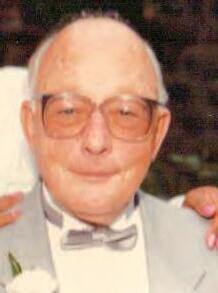
He received the school’s first Lindback Teaching Award in 1965, and was a frequent lecturer at numerous state and national veterinary meetings. Dr. Rhodes played a major role in the development of veterinary radiology that included a founding member and past president of the Educators in Veterinary Radiologic Science (the first veterinary radiology organization in US) and then the American Veterinary Radiologic Society, a member of numerous AVMA and AAHA advisory committees and the New York Academy of Science. He was a charter member and chair of the Organizing Committee for the American Board of Veterinary Radiology (the first clinical specialty approved by the AVMA), now the American College of Veterinary Radiology. He was also a founding member of the International Veterinary Radiology Society.

Among his national and international recognition, Dr. Rhodes earned the Distinguished Service Award from the American College of Radiology in 1999.
In addition to his professional pursuits, Dr. Rhodes was an avid horseman.
dr. Robert Jesse Rutman, biochemist, humanitarian and emeritus professor of biochemistry at Penn Vet, died peacefully at age 91 on September 20, 2010 in Phoenix, AZ. Dr. Rutman, a dedicated cancer research scientist and activist for Global Peace, Civil Rights and Women’s Rights, worked at Penn Vet for more than three decades.
Born on Long Island, NY to Eastern European Jewish immigrants, Dr. Rutman was an only child and earned a Bachelor of Science degree in biochemistry from Penn State University in 1940. In 1942, he married Julia Zubroff of Minersville, PA whom he later divorced.
Dr. Rutman served in World War II in the US Army Corps of Engineers in Galveston, TX. While there, he was assigned to the Manhattan Project and witnessed the development of nuclear weaponry.
In 1954, Dr. Rutman joined Penn as a research associate in the Department of Zoology. He then moved to the Department of Chemistry where he spent five years as a senior research associate before becoming associate professor. In 1968, Dr. Rutman joined the Department of Animal Biology at Penn Vet as an associate professor where he remained until his retirement in 1987. He served as an emeritus faculty for several years.
During his time at Penn Vet, Dr. Rutman was instrumental in setting up an exchange program between the Vet School and the University of Ibadan in Nigeria. Dr. Rutman’s life and career included many accomplishments, including authoring a myriad of scientific articles, working with Dr. Martin Luther King, Jr. on desegregation and serving as Secretary of Scientists Committee on Biological Warfare.
When Gerrie, Dr. Rutman’s second wife, whom he married in 1970, died from Multiple Myeloma in 1980, his efforts intensified in cancer research and the study of cancers in people of color, especially women. He received the Philadelphia Tribune Centennial Front Page Voice Award in 1984, and is listed in 200 World Community Leaders and 200 Intellectual Leaders of the World.
With Dr. Rutman’s great influence, daughter Rose Rutman, step-children Stephen Johnson (Med Sch.) and Ellen Kafalas, attended Penn. Two of his six grandchildren are currently enrolled at Penn.
Dr. Kimberly A. Agnello joined Penn Vet faculty as Assistant Professor of Orthopedic Surgery, Clinician-Educator, Department of Clinical Studies-Philadelphia.
New Bolton Center’s Drs. Gary Althouse, Sue McDonnell, Regina Turner and Dirk Vanderwall were invited to present research findings in their areas at the 2010 International Symposium on Equine Reproduction (ISER) in Lexington, Kentucky this summer.
Dr. David Artis was promoted to Associate Professor of Parasitology.
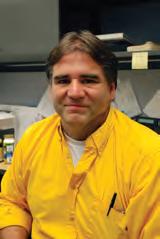

Dr. Sebastien Bauquier, lecturer in Clinical Studies-Philadelphia, passed ACVA board exams and is now a Diplomate of the American College of Veterinary Anesthesiologists.
Dr. Dorothy Brown was promoted to Professor of Surgery, Clinician Educator and Chair, Department of Clinical Studies – Philadelphia.
Dr. Mary Beth Callan was promoted to Professor of Medicine.
Dr. Roberta DiTerlizzi joined Penn Vet faculty as Assistant Professor of Clinical Pathology, Clinician-Educator, Department of Pathobiology.
Dr. Bernd Driessen was promoted to Professor of Anesthesiology, Clinician Educator. In addition, Dr. Driessen was invited to be part of the veterinary staff on-hand for the recent Dubai World Cup Races.
Dr. Kenneth J. Drobatz, director of Emergency Service at Ryan-VHUP, was honored by University of California-Davis School of Veterinary Medicine with the Alumni Achievement Award, which honors outstanding personal and professional contributions to veterinary science or one of its branches, contributions to veterinary practice in any of its forms, or service to mankind and the advancement of human welfare.
Dr. Amy Durham joined Penn Vet faculty as Assistant Professor of Anatomic Pathology, Clinician-Educator, Department of Pathobiology.
Ms. Christina Ehlers joined Penn Vet as Curriculum Manager in the Office of Student and Curricular Affairs.
Dr. Serge Fuchs was promoted to Professor of Cell Biology.
Dr. Claire Hankenson was promoted to Associate Professor of Laboratory Animal Medicine, Clinician Educator.
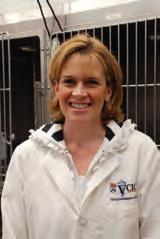
Dr. Anna Kashina was promoted to Associate Professor of Biochemistry.
Dr. Carolina Lopez joined Penn Vet faculty as Assistant Professor of Microbiology and Immunology.

Dr. James Marx joined Penn Vet as Assistant Professor of Laboratory Animal Medicine, Clinician-Educator, Department of Pathobiology.
Dr. Elizabeth Mauldin was promoted to Associate Professor of Dermatopathology, Clinician Educator.
Dr. Maeva May joined Penn Vet as a Lecturer, New Bolton Center Department of Clinical Studies.
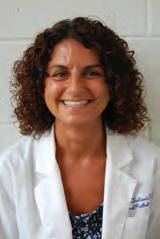
Dr. Ralph Meyer, assistant professor of Developmental Biology, has been awarded a Michelson Grant in Reproductive Biology. The grant, awarded by Found Animals, allows Dr. Meyer to continue his research over the next three years to develop a non-surgical sterilant/ technology for use in both male and female cats and dogs.
Dr. Michael Moyer earned the Student AVMA Community Outreach Award. This annual award recognizes excellence, innovation and enthusiasm in the field of clinical veterinary science and education.
Dr. David Artis Dr. Dorothy Brown Dr. Roberta DiTerlizzi Dr. Carolina LopezDr. Eric Parente, associate professor of Surgery at University of Pennsylvania’s School of Veterinary Medicine’s New Bolton Center, was invited to speak at the Veterinary Sport Horse Symposium Program in September 2010.
Dr. Louise Southwood Parente was promoted to Associate Professor of Emergency Medicine and Critical Care, Clinician Educator.
Dr. Alexander Reiter was promoted to Associate Professor of Dental and Oral Surgery, Clinician Educator.
Dr. Mary Robinson joined Penn Vet as a Lecturer, Clinical Studies at New Bolton Center.
Dr. Jeffrey J. Runge was promoted to Lecturer of Surgery.
Ms. Emily Savino has been named Nursing Supervisor at the Intensive Care Unit at Ryan-VHUP.

Dr. Barbara Dallap Schaer was promoted to Associate Professor of Emergency Medicine and Critical Care, Clinician Educator.
Phi Zeta Student Research Day is held annually to acknowledge scholarly achievement of VMD and VMD/PhD students at Penn Vet. The event showcases excellence in our student research and academic achievements at Penn Vet and provides an opportunity and a meeting place for students, residents and faculty to connect and enhance collaborations and communication between the basic and clinical researchers. It also allows colleagues and classmates to hear about the exciting research taking place in the School of Veterinary Medicine.
The 2010 program, held on March 25, featured six oral presentations by students (basic and clinical research), selectively chosen by a faculty panel of judges. Outstanding presenters of abstracts received awards of excellence following their oral presentations.
The keynote address was delivered by Dr. Michael Blackwell, former dean of the University of Tennessee College of Veterinary Medicine and former chief veterinarian of the United States Public Health Service (USPHS). As chief veterinarian, Dr. Blackwell was an advisor to the Surgeon General of the United States from 1994-1998. There was standing room only for his talk.
The dual degree oral presenters, and awards, respectively, were Gregory Rak (1st place), M. Noelle Knight (2nd place) and Catrina King (3rd place).
The VMD oral presenters were Sarah Ward (1st place), Kristina Simone (2nd place) and Breanna Caltagarone (3rd place).
Best Posters Prizes were awarded to Abigail Shearin (1st place), LaTasha Crawford (2nd place) and Sarah Cannizzo (3rd place).
The 2011 Phi Zeta Student Research Day event will take place on Thursday, March 31, 12 noon to 6:00 p.m. in the Hill Pavilion. For more information on the 2011 event, email resnews@vet.upenn.edu.
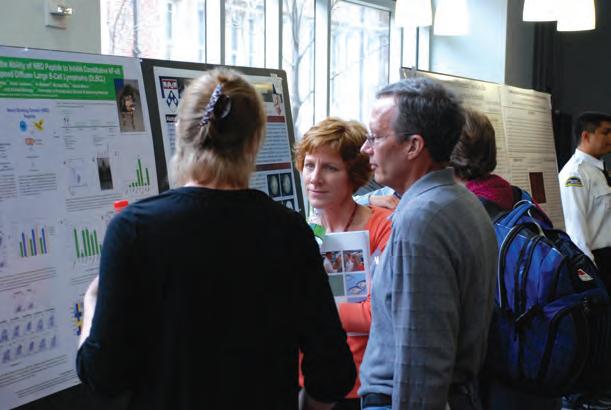
The Karreman family illustrates the many paths a veterinary education can take
B Y C O REEN H A GGERTYthe University of Pennsylvania boasts countless family legacies – where students follow in the education and career path as family members before them.
But at the School of Veterinary Medicine, our legacies are a bit different. From small animal care, to human research, to military service, to government oversight of the human food supply, to biodynamic dairy herd management and more, the options for graduating students are abundant.
While parents, children, siblings, aunts and uncles may all earn the VMD degree, each individual can paint his or her own unique career path.
One family, the Karremans, illustrates this point.
Born in Woods Hole, MA, Grace Karreman, C’76, V’82, spent her earliest years by the ocean and observing the life within it.
But when Grace’s father, George Karreman, moved his growing family to Philadelphia to pursue a professorship at Penn Medicine, Grace’s connection to the ocean was strained.
Grace entered her freshman year at Penn as a linguistics major. Soon, she realized, however, that she was not so adept at social sciences and later switched to a preveterinary medicine track. In 1978 she started at Penn Vet. Two years into her studies, Grace attended the AQUAVET program run by Dr. Donald Abt, V’61, GV’65, at Woods Hole, a program that married her passion for the ocean and her education.
After graduation, Grace married and moved to British Columbia, Canada to see the coast, sail the fjords, and begin a small animal practice in Vancouver.
In 1986, the University of Guelph’s Ontario Veterinary College created an aquatics program and Grace began pioneering work with remote fish farms. Here, she applied principles of livestock herd health medicine to farmed aquatics populations through a program she
siblings hubert, v’95, m’08 (left) is an organic dairy veterinarian in lancaster county, Pa and grace, c’76, v’82 (right) is a national manager for aquatic animal disease control for the canadian government.
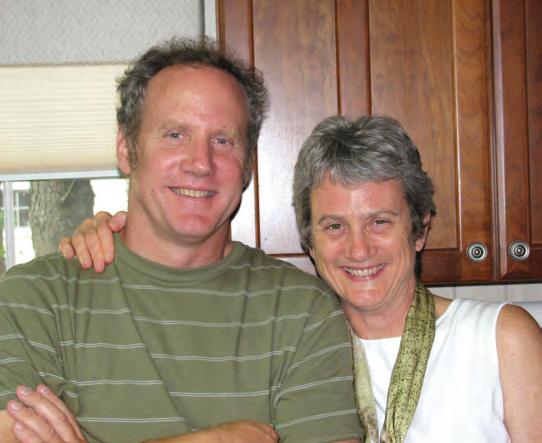
created called Cooperative Assessment of Salmon Health (CASH).
“The most important thing is to think critically and to use first principles of veterinary medicine,” said Grace. “Whether on land or in the ocean, the environment is both life support and a conduit for infection.”
Today, Grace works for the National Aquatic Animal Health Program (NAAHP), Canadian Food Inspection Agency, which looks at the infectious disease management of aquatic populations at a federal level. She is internationally recognized for her work on biosecurity and disease control, including emergency response and day-to-day disease prevention. Her work includes wild and commercially caught species.
Hubert Karreman, V’95, M’08, George Karreman’s third child, did not intend to follow in the footsteps of his siblings. Both Grace and Frank (an architect) graduated from Penn. Hubert enrolled at the University of New Hampshire and became a “back-to-the-lander.”
As a college sophomore, Hubert worked with the USDA Soil Conservation Service surveying land for conservation practices. Occasionally, he came into contact with dairy barns and cows, where he was intrigued by the food chain. How does soil affect feed? How does feed affect cows? And how do cows, which ultimately become food sources, affect us?
After traveling to Holland where he learned to milk cows and goats, Hubert came back to New Hampshire to test soil for commercial builders. But then he had
an epiphany: he wanted to manage soil for cows – not houses – and through a series of events decided to pursue veterinary medicine. Seven Stars Farm in Kimberton/ Phoenixville, an organic farm with 45 cows and 400 acres, laid the groundwork for Hubert’s veterinary career. As a biodynamic organic farm, the operation used only natural treatments on the milking herd and natural remedies to ensure rich soil life for crop production. In 1995, Hubert earned his VMD where he was especially interested in clinical medicine and herd health. Like his sister, he wanted to understand how the animals are affected by natural resources.
Today, Hubert is an expert in organic dairy health care and served on the AVMA Task Force on Complementary and Alternative Veterinary Medicine. In 2005, he was appointed by the USDA Secretary to the National Organic Standards Board for a five-year term, and was chair of the Livestock Committee. He has also given lectures at Penn Vet.
Although a clinical practitioner in Lancaster County, PA, Hubert has also worked with hundreds of certified organic farms in various countries and encourages farmers to enhance soil productivity, herd health and control pests by using natural medicines and soil fertilizers.
“Organic agriculture feeds right into One Medicine,” he said.
For Grace and Hubert, the paths of their veterinary careers may be different, but they share something in addition to their degree: they are both catalysts of change.
“The difference is in how my brother and I have expressed our veterinary passion professionally,” said Grace, “but the common thread is that he is a groundbreaker, and so am I. We are not afraid to take on new challenges and to use veterinary medicine to make things happen.”
In March 2011 my term as president of the Veterinary Medical Alumni Society will come to a close.
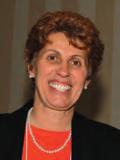
As I write my last Bellwether letter, I’d like to reflect on the past two years, during which one word surfaced again and again: “Change.” I have, during my tenure, witnessed some of the most dramatic changes within Penn Vet, its alumni, staff and students.
Of course one of the most major impacts on the School has been the challenging economic times, which has affected everyone in some way, shape or form. For Penn Vet, it meant a major state budget cut and decreased case loads in the hospitals, compelling the School to rethink its operations.
Although the process of operational change is difficult, it has resulted in positive enhancements and enthusiasm to move forward.
We have also been faced with finding solutions to the changes occurring within the veterinary profession and ensuring that our students’ education continues to not only be relevant, but be trail-blazing. One area that is especially important to recognize is the growing demand for veterinary professionals in the public health and government sectors. This evolution has led our faculty to find innovative curricula solutions and options in order to attract students to a career path related to food animal and global health, making Penn Vet graduates as competitive as ever.
Finally, alumni involvement has been one of another of the most noted changes I’ve seen during my two years
as VMAS president. I’ve seen alumni’s annual giving increase and have taken pride in noting that my peers have also carved out resources and time to support specific priorities and goals. More than ever, we are supporting student scholarships, volunteering time with committees and working with faculty, Dean Hendricks and the Alumni Office. In addition, alumni have been more proactive in fostering relationships with current Penn Vet students by providing externships with students and serving as mentors.
As I sat on the stage at the 2010 Penn Veterinary Medicine Commencement, I was impressed and inspired by the diversity of our students. Penn has always been a leader in diversity recognizing that it is through different backgrounds and experiences that new ideas are borne. This alone – the diversity of the Penn Vet student body – breeds a change in how we think about veterinary medicine – and about how we, as veterinarians, have an opportunity to impact the world around us for the better.
It has been an honor to serve as your president and to be a part of Penn Vet’s heritage and its future. My commitment to Penn Vet and its students, however, is far from over. Beyond this presidency, I will continue to be committed to their success. I hope you’ll join me in that mission.
For the most recent alumni updates visit www.vet.upenn.edu/alumniclassnotes
1940s 1960s
1947 — Dr. Glenn Lawhon (V’47), owner of the Sandy Memorial Animal Hospital in Hartsville, SC for 63 years, celebrated his 85th birthday on July 3, 2010. To honor Dr. Lawhon, Hartsville Mayor Mel Pennington issued a proclamation declaring July 3, 2010 as “Dr. Glenn J. Lawhon Jr. Day” and urged citizens “to join me in wishing him a happy 85th birthday and honoring him as a good and faithful servant of our great city.”
1964 — Willi Weichelt (V’64) was awarded the 2010 PVMA Lifetime Achievement Award on August 13, 2010 for selfless dedication to veterinary medicine, the health and welfare of animals and the betterment of the profession by addressing the need for animal emergency care and rehabilitation in his community, and for being an advocate and positive role model for veterinary medicine in the Commonwealth of Pennsylvania. Willi also just opened the West Chester Veterinary Rehabilitation Specialty Center, which offers several different types of physical therapy for animals.
1969 — Richard P. Streett, Jr. (V’69) serves as secretary of the American Veterinary Medical Foundation, a philanthropic extension of the American Veterinary Medical Association, which funds the AVMA and its initiatives, humane outreach and animal welfare, education and public awareness, research and student enhancement.
1970s
1971 — David Jackson (V’71) offers a free e-book on his new blog, YourPetYourVetAndYou.com. The e-book is called “Making It Work: A Veterinary Guide to Your Pet’s Health.”
Larry Samples (V’71) received the 2010 PVMA Distinguished Veterinary Service and the Board Service Recognition Awards on August 13, 2010 in recognition of his years of service to the field of large animal medicine, his dedication to the PVMA through his career and for his membership on the PVMA Board of Trustees from 1973 to 2009.
Leon Weaver (V’71), owner and operator of Bridgewater Dairy in Montpelier, OH, was appointed by Governor Ted Strickland to the Ohio Livestock Care Standards Board in April 2010.
1978 — The United Way of Boyertown Area, Gilbertsville, PA presented its Gold Award to Deborah Patt (V’78) for her increased giving to the 2009-10
United Way Campaign through the Patt Veterinary Hospital, which her parents, John Patt (V’52) and Virginia, started in 1952.
1979 — Amy Marder (CW’73, V’79) currently serves on the Advisory Board of the National Canine Research Council.
1980 — The National Academies of Practice (an organization founded in 1981 for interdisciplinary collaboration in human healthcare) elected and installed Steven W. Atwood, (V’80) MD as a distinguished practitioner on March 20, 2010 in Washington, D.C.
1982 — Sarah Ralston (CW’73, V’80, GR’82), associate professor at Rutgers University, NJ, won the 2010 SEBS Academic Professional Excellence Award under the category of Academic Innovation. As noted in her nomination letter, “For 20 years, Dr. Sarah L. Ralston has developed and implemented several creative academic innovations that have raised the level of excellence in the School of Environmental and Biological Sciences. She has taken advantage of the power of the Internet to enrich her Horse Management and Equine Nutrition courses for undergraduate, graduate and continuing education students and offered these courses online to students throughout the United States.”
1984 — Mary Lombardo (V’84) received the Veterinarian of the Year Award on August 13, 2010 by the PVMA in recognition of her outstanding work and dedication to the health and welfare of surrendered commercial kennel dogs, and for her commitment to educating the public, breeders and kennel owners about the proper care and vaccination of animals.
On Sunday September 19, 2010, Andrew Nebzydoski (V’84) completed his first 100-mile bike marathon in the Tour de Shunk in Monroeton, PA.
Stephen J. Peoples (V’84) MS has been appointed to the Orthopaedic Institute of Medicine Task Force on Conflict of Interest. He was also recently elected Chairman of the Board of Governors of the Pennsylvania Human Implant Performance Laboratory. He is currently serving as visiting associate professor of orthopaedics at the University of Illinois Medical Center at Chicago and providing consulting services to the healthcare industry.
1985 — Shelley Epstein (V’85) was highlighted in the September issue of Veterinary Practice News for her career path and homeopathic choices for care in her small animal practice in Wilmington, DE.
1986 — The 2010 PVMA Animal Welfare Advocacy Award was presented to Tom Parsons (V’86, GR’89) on August 13, 2010 in recognition of his compassion, dedicated professional leadership, and innovative vision in the improvement of swine well being, specifically related to the redesign of the newly reopened Swine Teaching and Research Facility at Penn Vet’s New Bolton Center.
Kim Blackwell (V’86, GEN’87, GR’88), professor at George Mason University, published an article in Nature Reviews Neuroscience, 11:239-251 (2010): Kotaleski, J.H. and Blackwell, K.T. “Modeling the molecular mechanisms of synaptic plasticity using system biology approaches.”
1987 — Susan J. Colbassani (V’87) was highlighted in the October 6, 2010 The Abington Journal for offering pet owners a more holistic approach to diagnosis and treat using Traditional Chinese Veterinary Medicine.
1988 — Eric Dunayer (C’79, V’88) MS, DABT, DABVT serves as a senior toxicologist at the ASPCA Animal Poison Control Center (APCC) as well as consultant on the toxicologist section of the Veterinary Information Network.
The USDA Animal and Plant Health Inspection Service named Patrice Klein (V’88) the Chronic Wasting Disease program manager, effective June 21, 2010. Prior to this appointment, Dr. Klein served as a senior staff veterinarian and avian disease specialist at the USDA/ APHIS/Veterinary Services – National Center for Animal Health Programs, Riverdale, MD working as a national program coordinator for Notifiable Avian Influenza (H5/ H7 LPAI and HPAI) disease control and prevention in commercial poultry and live bird marketing systems. She also currently serves as the AVMA VMAT2 team commander and volunteers as veterinary director for Second Chance Wildlife Center in Maryland since 2001, providing veterinary care to more than 4,000 wildlife rehabilitation animals per year.
1990 — Michael R. Moyer (V’90) received the Student AVMA Community Outreach Excellence Award, presented at the AVMA 147th Annual Convention in Atlanta Georgia in August, 2010. The Student AVMA presents this award to recognize a professor who goes beyond collegiate responsibilities to focus on education in the community. Dr. Moyer is the Rosenthal Director of Shelter Animal Medicine at the University of Pennsylvania School of Veterinary Medicine and the owner of Bridgewater Veterinary Hospital in Bensalem, PA. He is president-elect of the American Animal Hospital Association, and is past president of both the
Pennsylvania Veterinary Medical Association and the Veterinary Medical Alumni Society of Penn Veterinary Medicine.
1991 — Christopher Bonar (V’91), DACZM became board-certified in October, 2009 as a Diplomate of the American College of Zoological Medicine. In May of 2010, Dr. Bonar left the Cleveland Metroparks Zoo after nearly 16 years to become chief veterinarian of the Dallas World Aquarium.
Michael Dym (V’91) hosts “Dr. Dym’s Vet Blog” on the PetMeds.com® website, addressing issues ranging from why cats snore to treatment options for canine degenerative disc disease.
Carrie Schlachter (V’91) IVC serves as medical director and staff veterinarian at the Circle Oak Equine Clinic, a private, state-licensed veterinary facility in Petaluma, CA, specializing in sports medicine and rehabilitation and fitness services for active and retired performance horses. While at Penn Vet, Dr. Schlachter received the Charles F. Reid Clinical Excellence Award for Sports Medicine and Imaging as well as numerous scholarships. She has also served as a member of the Large Animal Services External Advisory Board of the University of California, Davis, Veterinary Hospital and authors a veterinary column for Ride Magazine
1993 — Adam Denish (V’93) was the vet for the City of Philadelphia Police Canine Department for 13 years, and is now in charge of Arcadia University’s Lab Animal Department and serves on its Institutional Animal Care and Use Committee. For the last seven years, Adam has been director of veterinary services for the Elmwood Park Zoo in Norristown, PA, as well as the consulting veterinarian for the Bucks County Zoo for two years. Adam’s family includes a wife, two children and 25 pets. He is working to attain his second black belt in martial arts.
1994 — Camille DeClementi (V’94) DABT, DABVT is responsible for the management of medical records in the Animal Health Services Department, which includes the ASPCA Animal Poison Control Center, Bergh Memorial Animal Hospital and the ASPCA Mobile Clinics.
The 2010 Public Service Award of Merit of the Pennsylvania Veterinary Medical Association (PVMA) was awarded to Kenton Rexford (V’94) on August 13, 2010 in recognition of his instrumental founding role in the creation of the non-profit organization Animal Care and Assistant Fund (ACAF) and for its efforts to provide funds for the treatment of pets whose owners cannot afford care.
“Sea” Rogers Williams, III (V’94), science director and attending veterinarian at the National Marine Life Center, spoke at the Provincetown Center for Coastal Studies in Massachusetts in April, 2010 on “One Health, the role of the National Marine Life Center and the implications for improving the health of stranded marine animals, the environment and human health.” The talk was sponsored by the Community Leadership Institute of Cape Cod and the Islands and focused on the environment of Cape Cod. Dr. Williams also owns and operates the Vineyard Veterinary Clinic in Edgartown, on Martha’s Vineyard.
1997 — Stacy Fuchino (V’97) published Head to Tail Wellness: Western Veterinary Medicine Meets Eastern Wisdom, which links a pet’s overall makeup with its health and wellness. Using Asian therapies – a blend of Western veterinary medicine with the wisdom of the East – pet owners are shown how to expand the limits of their pet care in a way that specifically and organically suits the individual pet. Stacy is a graduate the Chi Institute of Traditional Chinese Medicine and has been practicing a blend of East/West veterinary pet care for more than 10 years. Dr. Fuchino is also producer of Housecat Housecall® on Animal Planet.
John Lewis (V’97) and wife Kim welcomed a baby boy, Quinn, on March 31, 2010. Quinn weighed 7 lbs., 5 oz. and was 18” when he was born.
Richard A. Zappala (V’97) teaches the course “Bringing Recovery to Diverse Populations” as part of the UCLA Extension program. Dr. Zappala serves as assistant to the director of client services at Cri-Help, Inc. in North Hollywood, CA after completing the UCLA Extension Certificate Programs in Alcohol and Drug Abuse Studies and Counseling in 2008. He also worked as a patent attorney for a law firm in Washington, D.C. and later as an equine veterinarian in Bucks County, PA before his career in addiction counseling.
1998 — Joan Capuzzi (C’86, V’98) published Puppies: A Complete Guide to Raising a Happy Puppy in a Positive Environment, which hit book stores on July 1, 2010.
1999 — Emily Graves (V’99) and her husband, Eric Liprandi, welcomed a healthy baby boy, Michael, on April 9, 2010. Michael weighed 8 lbs., 3 oz. and was 21.5”. All is well at home with his big sister, Nivea, a black Labrador retriever.
medicine) at Garden State Veterinary Specialists in Tinton Falls, NJ followed by a three-year residency in small animal internal medicine at the University of Tennessee College of Veterinary Medicine in Knoxville and became board certified in small animal internal medicine in June of 2008. Amy is currently employed as a clinical assistant professor of medicine at the University of Tennessee and teaches general medicine through a community practice program she helped to co-create.
2001 — Since 2007, Leo Egar (V’01) has served the animals at the Arizona Humane Society through spay and neuter services and investigations of animal cruelty. Before coming to AHS, he worked with the Rural Area Veterinary Services program of the Humane Society of the United States to lead spay/neuter service trips to remote areas of the county such as to Native American reservations. He also provided veterinary medical response to major disasters including the 2004 Indian Ocean tsunami and Hurricane Katrina.
Elizabeth Johnson (V’01), in her role as manager of Veterinary Services at Putney (a pet pharmaceutical company), helps to introduce generics to the pet pharma industry by providing medical and technical customer support to veterinary customers as well as strategic input into future product developments.
Brennen McKenzie (V’01) MA works as a small animal veterinarian in private practice in California, with a special interest in promoting science-based veterinary medicine and is currently chair of the Practitioner Committee for the Evidence-Based Veterinary Medical Association. He has published articles on evidence-based medicine in veterinary science journals, and writes about both sciencebased and alternative veterinary medicine as the SkeptVet.
2002 — Kate Masek Hammerman (V’02, GR’06) completed her postdoctoral studies at Harvard and has taken a new position at Pfizer as a pathologist and principal scientist in investigative pathology.
2004 — Lori Duggan-Mazzagatti (V’04) owns a traveling pet zoo called Party Animals to Go, which aims to educate and expose children and community groups to different animals. In addition to dogs and cats Lori also has a strong interest in small mammals and reptiles, and also volunteers with For Bunny Sake Rabbit Rescue.
2000 — Amy L. Holford (V’00) DACVIM completed a two-year internship (general and internal
2005 — As owner of Wandering Vet: Veterinary Housecalls in San Francisco, CA, Adam J. Behrens (V’05) offers home care veterinary services for cats, dogs and small mammals. He has also volunteered with Veterinary Street Outreach Services, providing free care to the San Francisco homeless population.
2009 — The Delaware County SPCA, Springfield, PA, hired Kimberly Boudwin (V’09) as new staff veterinarian in April, 2010.
Rachel Toaff-Rosenstein (V’09) and husband Arye welcomed twins Matan (boy) and Gefen (girl) on February 22, 2010.
2000 Teresa Garofalo on August 21, 2010.
1989 Deborah J. Pitt on November 19, 2009.
1979 Francis “Frank” Bertozzi, Jr. on March 10, 2010.
1973 Ronald F. Hurley on January 28, 2010.
1971 James F. Hyssong on March 14, 2010.
1965 Albert F. Moraska on May 2, 2010.
1964 Jonathan Meincke on January 23, 2010.
1962 John T. Lopatofsky on September 9, 2010.
1958 Donald “Doc” Williamson Hostettler on February 12, 2010.
Bruno J. Tibolla Jr. on October 3, 2009.
1955 William Harker Rhodes on September 29, 2010.
1948 David M. Hopkins on February 11, 2010. Marvin Rothman on March 17, 2010.
1943 Ira M. Fridirici on December 7, 2009.
Robert E. Swope on March 29, 2010.
1939 William “Bud” Wright on July 10, 2010.
Have you received a promotion, gotten married, had a baby or received an award? Have you volunteered somewhere special, moved into a new building, ventured into a new business or discovered the cure for avian flu? Please share with us all of your good news to include in the CLASS NOTES section of the Bellwether and the vet.upenn.edu website. All residents, interns and fellows are also invited to share!
Forward all alumni news to Coreen Haggerty, director of Alumni Relations at haggertc@vet.upenn.edu or write Office of Alumni Relations, 3800 Spruce Street, Suite 172 E, Philadelphia, PA 19104.
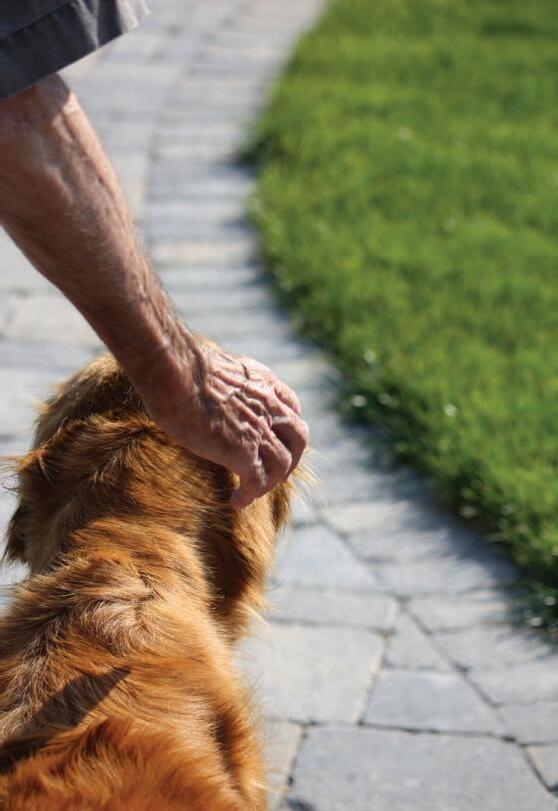
Support Penn Veterinary Medicine with a gift of $10,000 or more and in return receive guaranteed payments for life…a portion of which may be tax free. A charitable gift annuity is a flexible way for you to make a gift and receive fixed payments for yourself and/or others you may choose.
penn’s chARitAble Gift Annuity OffeRs yOu:
~ A safe, simple way to turn valued assets into guaranteed payments for life.
~ Tax advantaged giving—a charitable gift annuity is a gift to Penn Vet and therefore qualifies you for an immediate income tax deduction.
~ Most importantly, every new gift strengthens the programs you support and, through your involvement at this critical time, helps empower Penn Vet to pursue its ambitious vision with confidence.
If you would like information on how you may benefit from a charitable gift annuity, simply contact: Lynn Ierardi, JD, Office of Gift Planning at 800.223.8236, lierardi@dev.upenn.edu or visit us at www.upenn. planyourlegacy.org.
Penn Veterinary Medicine
3800 Spruce Street
Philadelphia, PA 19104-6008
Monday, December 6, 2010
American Association of Equine Practitioners Annual Convention Hilton Baltimore – Baltimore, MD
Penn Vet is proud to print Bellwether magazine on FSC (Forest Stewardship Council) certified paper, which supports the growth of responsible forest management worldwide through its international standards.
Monday, February 14 and Tuesday, February 15, 2011
Westminster Kennel Club 135th Annual Dog Show
Madison Square Garden (Pennsylvania Plaza) – New York, NY
Penn Vet Alumni Reception – 6:30pm – 8pm (Key Ballroom 2)
Tuesday, December 7, 2010
First Tuesday Lecture Series at New Bolton Center: “Comprehensive Anesthesia and Pain Management: Beyond Bute”
New Bolton Center, Widener Hospital, Woerner Amphitheatre
Presented by Dr. Kirsten Wegner, Section of Anesthesia and Critical Care
JANUARY 2011
Tuesday, January 4, 2011
First Tuesday Lecture Series at New Bolton Center: “Hind-limb Lameness – Is it the suspensory ligament or something else?”
New Bolton Center, Widener Hospital, Woerner Amphitheatre
Presented by Dr. Janik Gasiorowski, Large Animal Surgery
Saturday, January 8 through Saturday, January 15, 2011
Pennsylvania Farm Show
PA Farm Show Complex & Expo Center, North Cameron and Maclay Streets, Harrisburg, PA
Sunday, January 16, 2011
North American Veterinary Annual Conference Orlando, FL
Penn Vet Alumni Reception – 7pm-9pm
Sunday, January 30, 2011
Animal Lovers Lecture Series:
“Quality of Life: Getting Your Dog Involved”
Dog Training Club of Chester County, Exton, PA 19341
Dr. Cindy Otto and Dr. Ilana Reisner will explain the significance of how a happy dog is a healthy dog.
February 16, 2011
Penn Science Café – Why You Can Hardly Swing a Dead Cat Without Hitting a Dead Cat in Animal Shelters Today: The Obvious, the Occult and the Counterintuitive World of Animal Sheltering
Presented by Michael Moyer, VMD, Rosenthal Director of Shelter Animal Medicine
MARCH 2011
Wednesday, March 2 and Thursday, March 3, 2011
111th Penn Annual Conference (Lectures)
“Partners in Care”
Sheraton Philadelphia City Center Hotel – Philadelphia, PA
Join fellow alumni and colleagues at the single largest annual gathering of Penn Veterinary Medicine Alumni.
Friday, March 4, 2011
111th Penn Annual Conference (Wet Labs)
University of Pennsylvania, Ryan Veterinary Hospital – Philadelphia, PA
APRIL 2011
Tuesday, April 5, 2011
Friends of New Bolton Center Donor Recognition Dinner
New Bolton Center, Kennett Square, PA
Please contact Pat Hall at 610-925-6500 for details.
MAY 2011
Friday, May 13 and Saturday, May 14, 2011
Alumni Weekend 2011: Save the Date!
University of Pennsylvania, Philadelphia Campus and New Bolton Center
We remember all Penn Vet alumni with special celebrations for classes ending in ‘6 and ‘1 including the 25th reunion of the Class of 1986 and the 50th reunion of the Class of 1961. Please contact Coreen Haggerty at haggertc@vet.upenn.edu or 215-898-1481 for details.